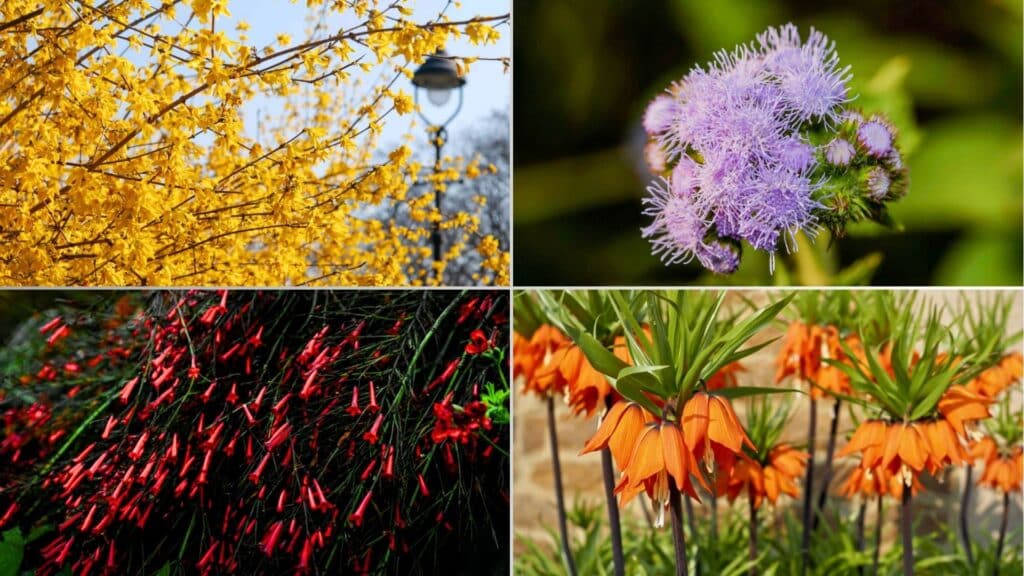When planning a garden, choosing the right flowers is key. You want a variety that will add beauty and interest to your outdoor space. If you’re looking for stunning flowers that start with the letter “F,” you’re in luck.
This article will introduce you to 31 fabulous flowers beginning with “F” that can take your garden to the next level. From classic favorites to lesser-known varieties, you’ll discover various options for your preferences and gardening skills.
Get ready to explore a world of fascinating flowers, including Freesias, Forget-Me-Nots, and Fuchsias.
Whether you’re an experienced gardener or just starting, this list will help you find the perfect “F” flowers to create a captivating outdoor oasis.
Flowers That Start with F
1. Fuchsia
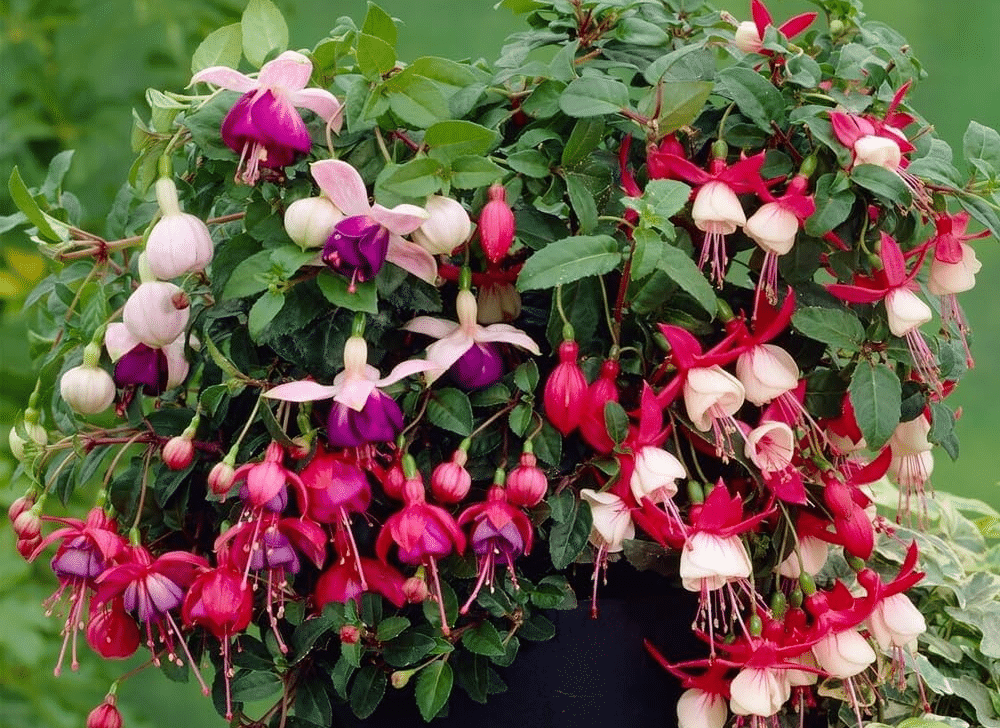
Fuchsias are beautiful flowering plants known for their vibrant, pendulous blooms that resemble dancing ballerinas.
The flowers come in various colors, including pink, purple, red, and white, and often have contrasting sepals and petals. Depending on the variety, fuchsias can be grown as hanging baskets, shrubs, or even small trees.
- Origin: Fuchsias are native to Central and South America, with a few species extending to New Zealand and Tahiti.
- Blooming Month: Most fuchsias bloom from late spring through fall, providing months of colorful displays.
- Height: Fuchsia plants can vary in height depending on the species and growing conditions, ranging from 6 inches to over 10 feet tall.
- Care: Fuchsias thrive in partial shade and well-drained soil. They prefer cooler temperatures and regular moisture. Protect them from harsh sunlight and prune them back in early spring to encourage bushier growth.
- Uses: Fuchsias are primarily used as ornamental plants in gardens, hanging baskets, and containers. They attract hummingbirds and make excellent additions to shade gardens or patio areas.
- Benefits: Apart from their aesthetic appeal, fuchsias have been used in traditional medicine to treat various ailments, such as high blood pressure and digestive issues.
Fun Facts
- There are over 100 recognized species of fuchsia and thousands of cultivars.
- The fruit of some fuchsia species is edible and can be made into jams or jellies.
- Fuchsias are named after the German botanist Leonhart Fuchs, who lived in the 16th century.
2. Forsythia
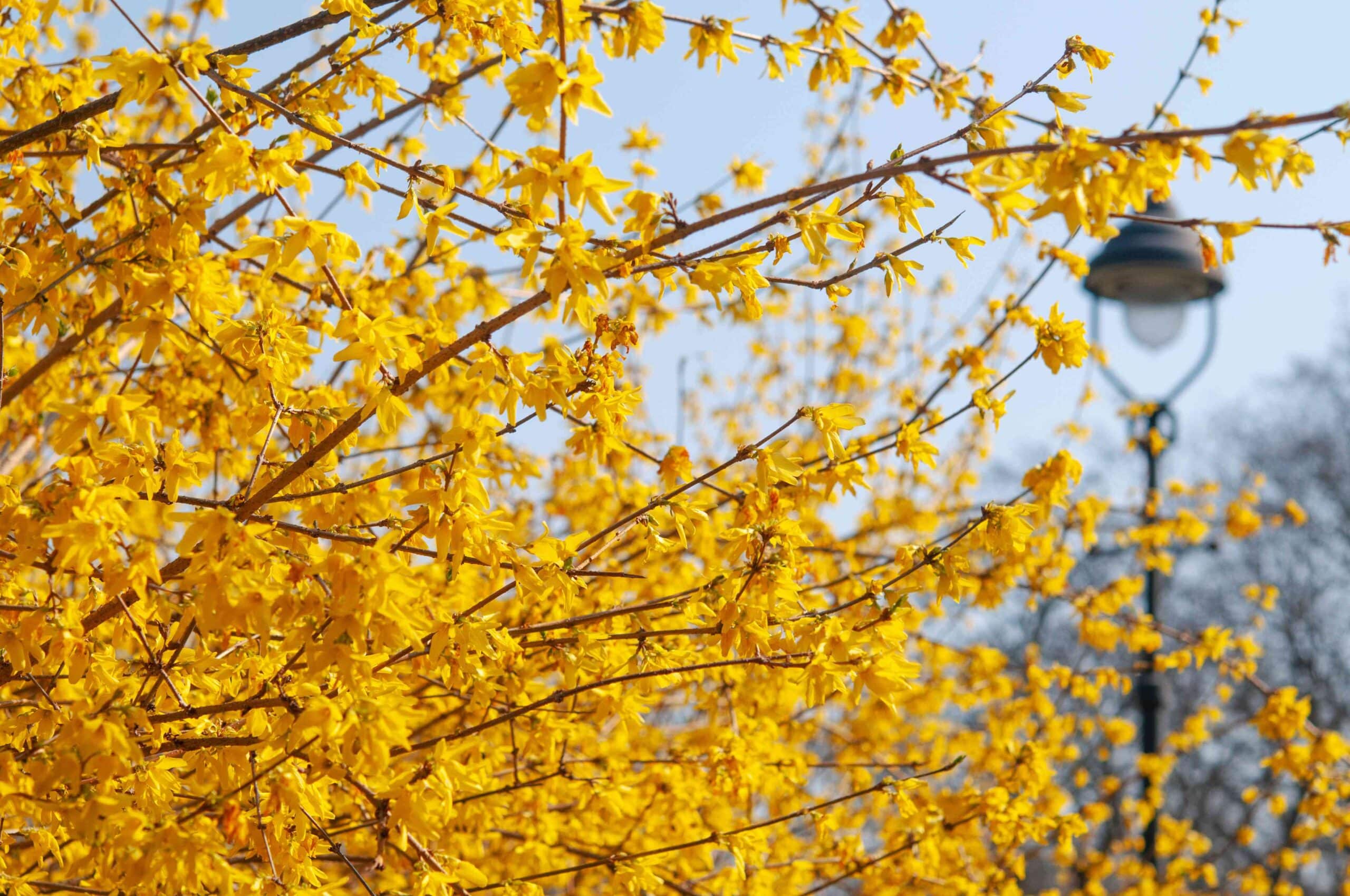
Forsythia is a deciduous shrub that displays a spectacular show of bright yellow flowers in early spring before the leaves emerge.
The four-lobed flowers grow in clusters along the stems, creating a striking contrast against the bare branches. Forsythia is often used as a garden hedge, border, or specimen plant.
- Origin: Forsythia is native to eastern Asia, particularly China, Korea, and Japan.
- Blooming Month: Forsythia typically blooms in early spring, from March to April, depending on the region.
- Height: Forsythia shrubs can grow between 3 to 10 feet tall and wide, depending on the variety and growing conditions.
- Care: Forsythia is a low-maintenance shrub that thrives in full sun to partial shade and well-drained soil. Prune the shrub immediately after flowering to maintain its shape and promote healthy growth.
- Uses: Forsythia is primarily used as an ornamental plant in gardens and landscaping. Its early spring blooms make it popular for adding color to the landscape after a long winter.
- Benefits: Forsythia has been used to treat various ailments, such as fever, inflammation, and respiratory issues, in traditional Chinese medicine.
Fun Facts
- Forsythia is named after William Forsyth, a Scottish botanist who lived in the 18th century.
- The flowers of forsythia are edible and can be added to salads or used as a garnish.
- Forsythia is one of the earliest flowering shrubs in spring, often blooming before other plants.
3. Foxglove
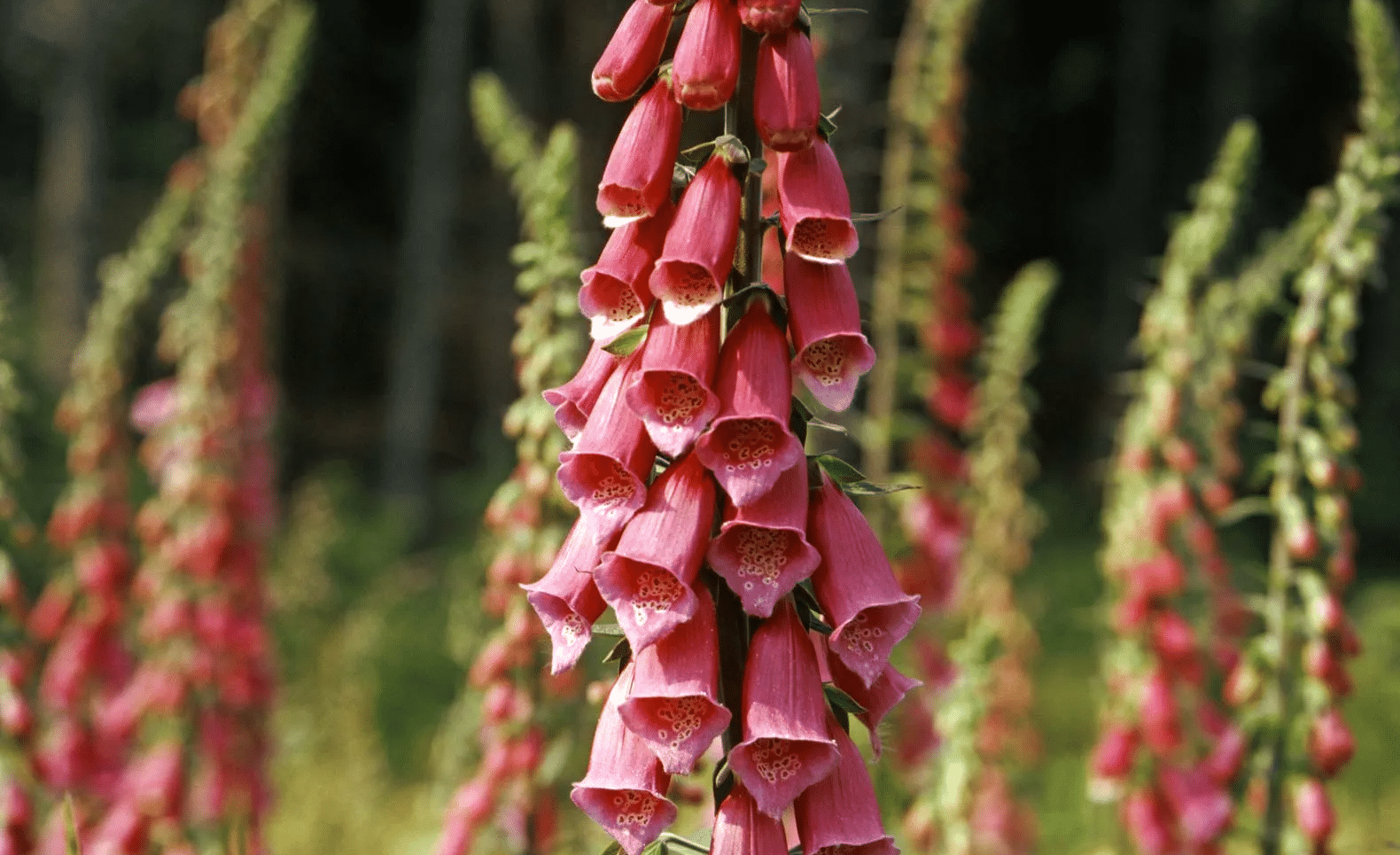
Foxglove is a biennial or short-lived perennial plant known for its tall spikes of tubular, bell-shaped flowers. The flowers come in various colors, including pink, purple, white, and yellow, and are often adorned with spotted throats.
Foxglove adds a vertical accent to gardens and attracts bees and hummingbirds.
- Origin: Foxglove is native to Europe, western Asia, and northwestern Africa.
- Blooming Month: Foxglove typically blooms from late spring to midsummer, from May to July.
- Height: Foxglove plants can grow between 2 to 6 feet tall, depending on the variety and growing conditions.
- Care: Foxglove prefers partial shade and well-drained soil rich in organic matter. They are self-seeding plants, so remove the flower stalks after blooming to prevent excessive spread. Note that all parts of the foxglove plant are toxic if ingested.
- Uses: Foxglove is grown primarily for its ornamental value in gardens, cottage gardens, and woodland settings. They make excellent cut flowers for floral arrangements.
- Benefits: Foxglove has been used in traditional medicine to treat heart conditions, but it should only be used under medical supervision due to its toxicity.
Fun Facts
- The scientific name for foxglove is Digitalis, which means “finger-like,” referring to the shape of the flowers.
- Foxglove is the source of the heart medication digoxin used to treat various heart conditions.
- According to folklore, fairies used foxglove flowers as gloves, hence the name “foxglove.”
4. Freesia
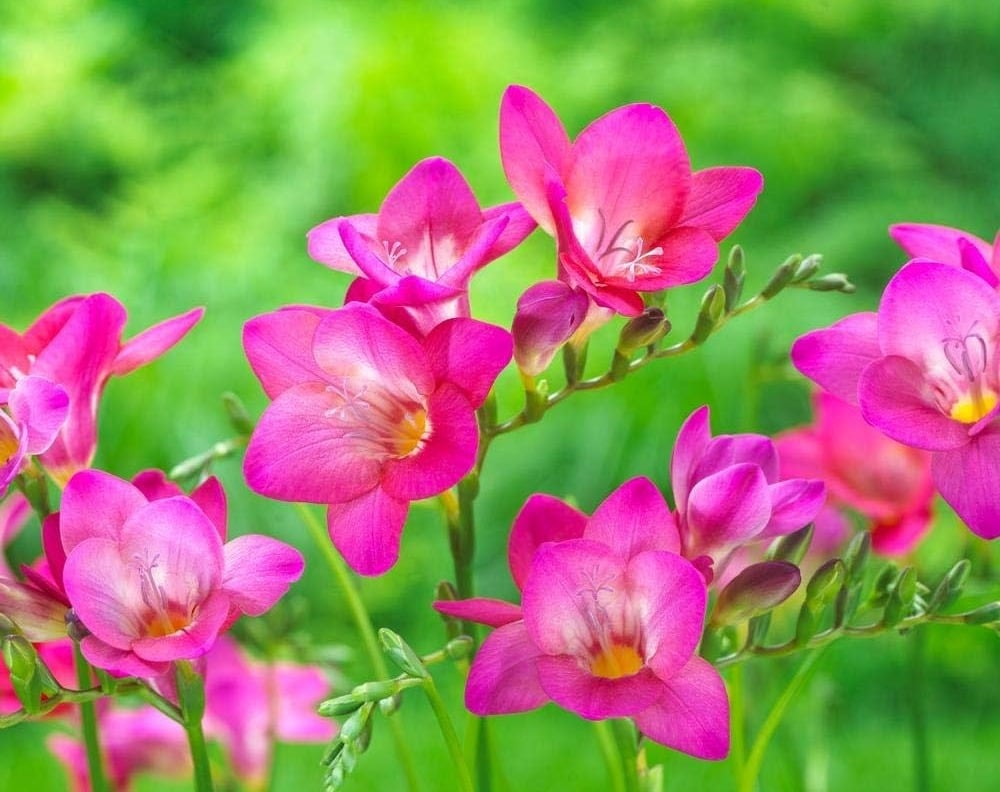
Freesias are small, herbaceous plants known for their fragrant, funnel-shaped flowers that bloom in clusters on slender stems.
Freesias come in various colors: white, yellow, orange, pink, red, and purple. They are popular cut flowers often used in floral arrangements and bouquets.
- Origin: Freesias are native to southern Africa, specifically South Africa.
- Blooming Month: Freesias typically bloom from late winter to early spring, from January to April, depending on the region and growing conditions.
- Height: Freesia plants can grow 6 to 18 inches tall, depending on the variety.
- Care: Freesias prefer full sun to partial shade and well-drained soil. They grow from corms, which should be planted in fall for spring blooms. After flowering, allow the foliage to die naturally to help the corms store energy for the next season.
- Uses: Freesias are primarily used as cut flowers in floral arrangements and bouquets. They are also grown as ornamental plants in gardens and containers.
- Benefits: Freesia flowers have a sweet, citrusy fragrance that is known to calm and uplift moods.
Fun Facts
- Freesias are named after the German botanist Friedrich Heinrich Theodor Freese.
- In the language of flowers, freesias symbolize friendship, trust, and thoughtfulness.
- Freesias are among the most popular cut flowers worldwide, thanks to their long vase life and attractive fragrance.
5. Fairy Primrose
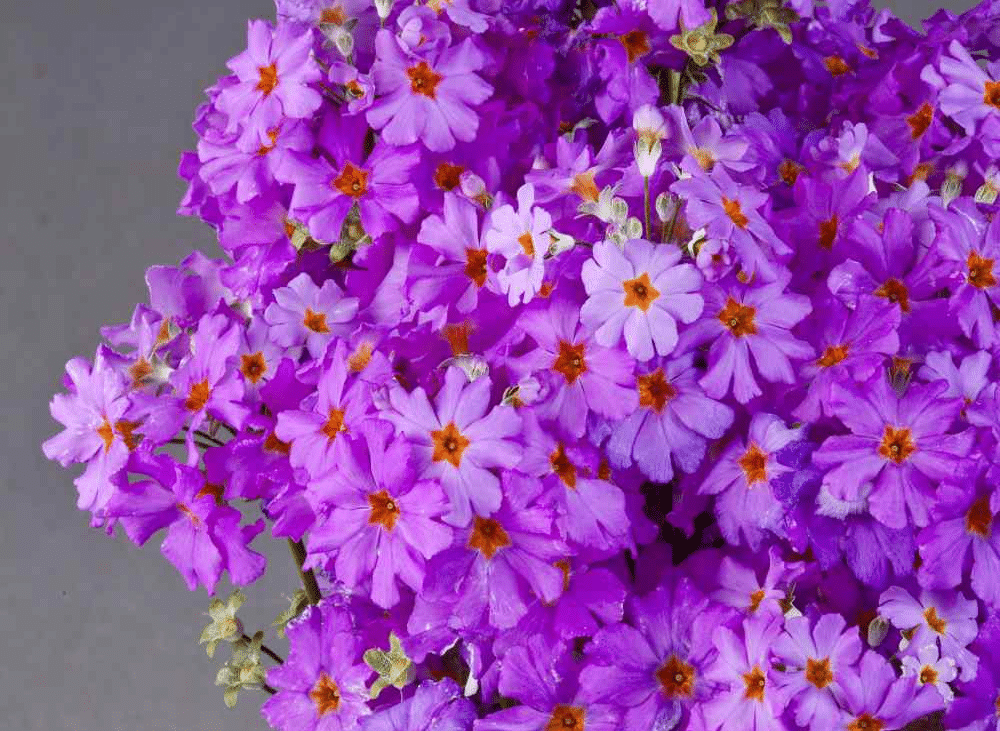
Fairy Primrose (Primula malacoides) is a charming, compact plant with clusters of small, delicate flowers in shades of pink, purple, or white.
The flowers are held above a rosette of soft, green leaves, creating a whimsical and enchanting appearance. Fairy Primrose is a popular choice for indoor plants and outdoor containers.
- Origin: Fairy Primrose is native to the mountainous regions of southern China and northern Myanmar.
- Blooming Month: Fairy Primrose typically blooms from late winter to early spring, from January to April.
- Height: Depending on the variety and growing conditions, fairy primrose plants can grow between 6 and 12 inches tall.
- Care: Fairy Primrose prefers cool temperatures, partial shade, and moist, well-drained soil. They benefit from regular fertilization during the growing season and should be deadheaded to encourage continuous blooming.
- Uses: Fairy Primrose is primarily an ornamental plant for indoor containers, terrariums, and outdoor shade gardens. It makes a lovely addition to spring flower arrangements.
- Benefits: Fairy Primrose adds color and charm to indoor spaces during winter when outdoor plants are dormant.
Fun Facts
- The name “Primrose” comes from the Latin word “primus,” meaning “first,” as they are often among the first flowers to bloom in spring.
- In the language of flowers, primroses symbolize young love, innocence, and renewal.
- Fairy Primrose is a popular choice for Valentine’s Day gifts and decorations.
6. Frangipani
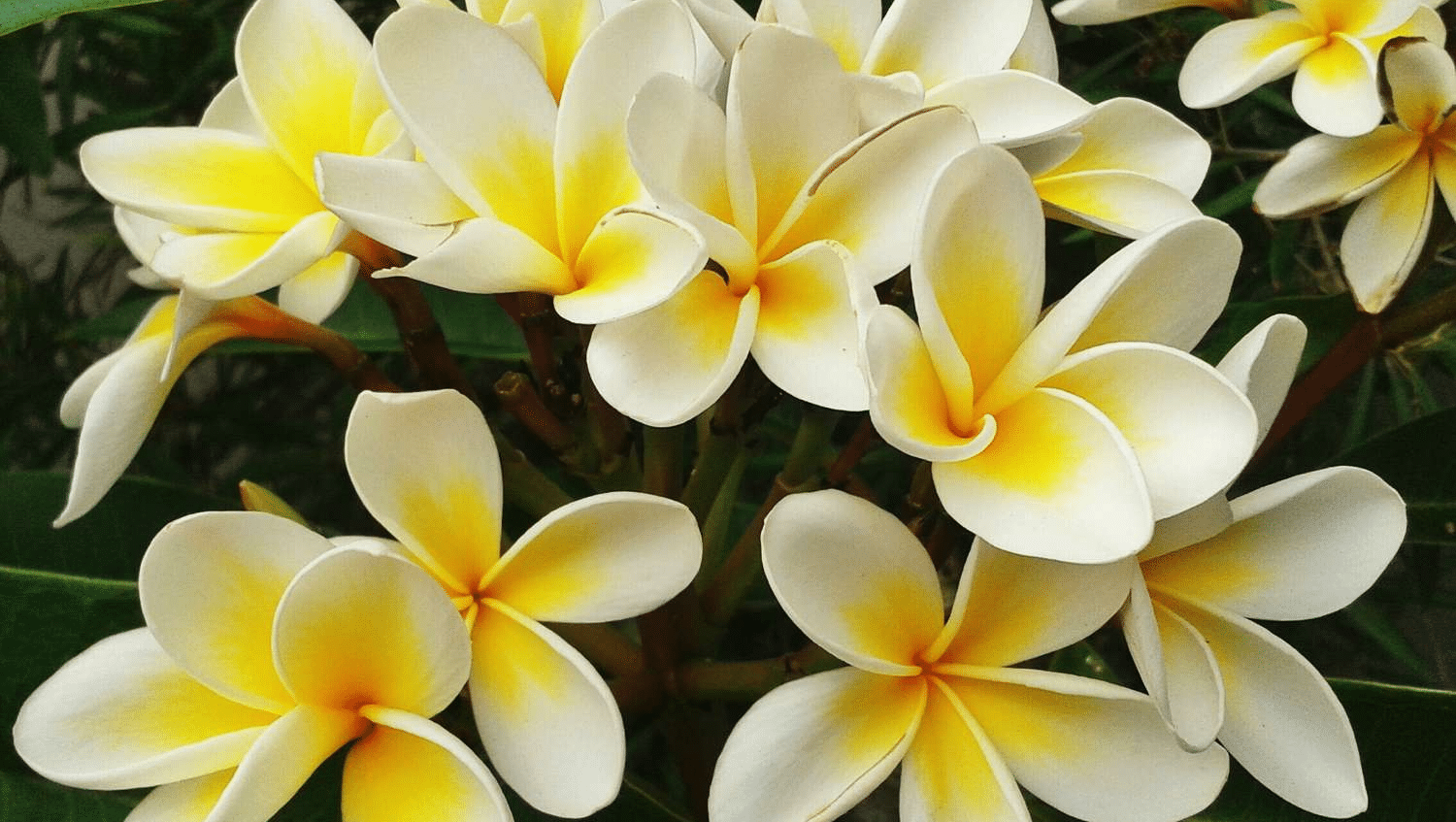
Frangipani (Plumeria) is a small, deciduous tree or shrub known for its fragrant, waxy, and colorful flowers. The flowers have five petals and come in shades of white, yellow, pink, and red, often with a contrasting center.
Frangipani plants have thick, fleshy branches and long, narrow leaves.
- Origin: Frangipani is native to the tropical regions of the Americas, from Mexico to Venezuela and the Caribbean.
- Blooming Month: Frangipani typically blooms from late spring through fall, from May to October, depending on the region and climate.
- Height: Frangipani trees with a spreading canopy can grow between 15 to 25 feet tall.
- Care: Frangipani prefers full sun and well-drained soil. Once established, they are drought-tolerant and require minimal watering. Prune the tree after flowering to maintain its shape and remove dead or damaged branches.
- Uses: Frangipani is widely used as an ornamental tree in tropical and subtropical gardens. The fragrant flowers are often used in leis, perfumes, and tea-making.
- Benefits: Frangipani has been used in traditional medicine to treat various ailments, such as fever, inflammation, and skin conditions.
Fun Facts
- In Polynesian culture, frangipani flowers are associated with weddings and are often worn by brides in their hair or as leis.
- The sap of the frangipani tree is used as a natural rubber and has been used to make chewing gum.
- Frangipani is the national flower of Nicaragua and Laos.
7. Firecracker Flower
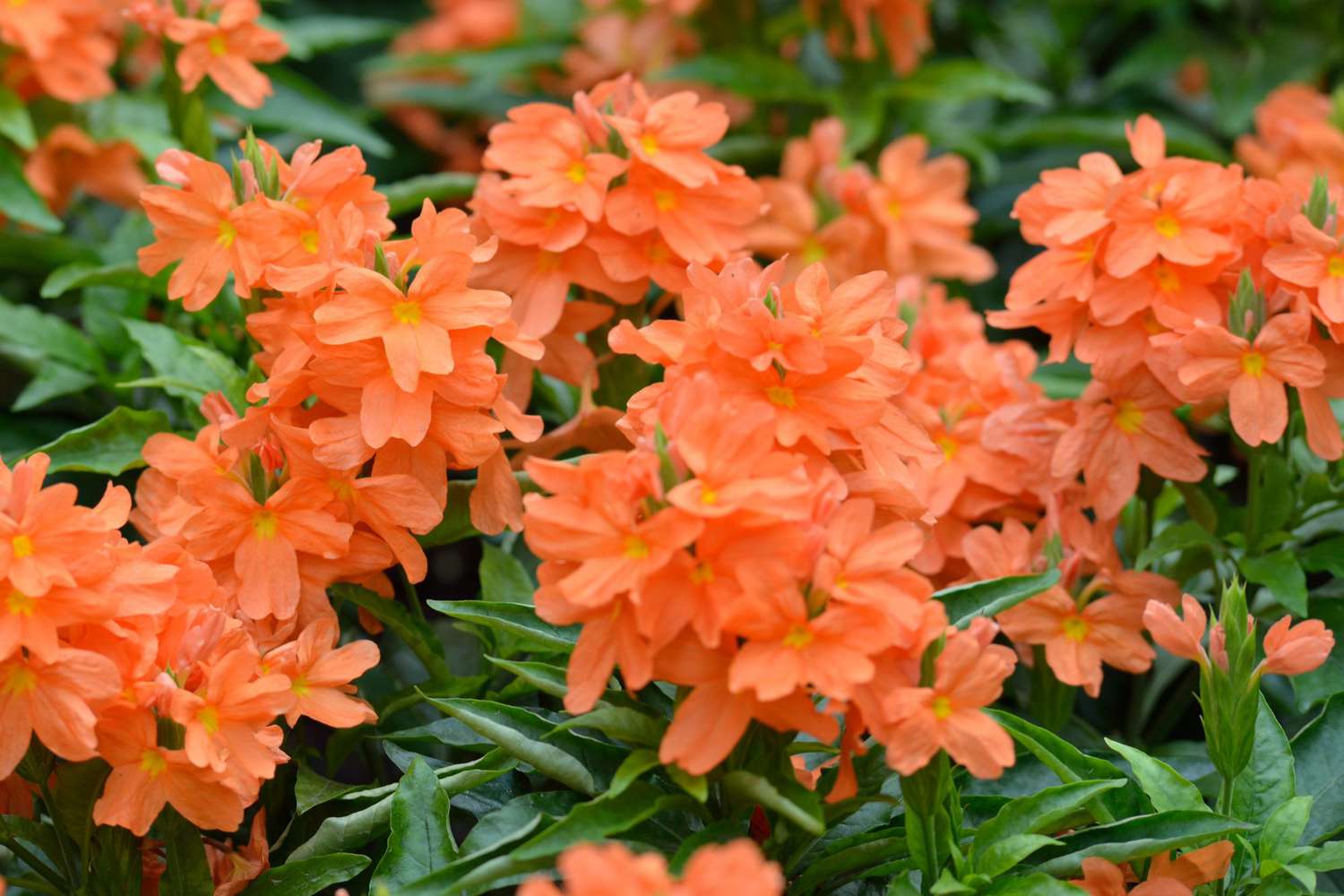
Firecracker Flower (Crossandra infundibuliformis) is a tropical evergreen shrub known for its vibrant, tubular flowers that resemble firecrackers.
The flowers are usually orange or yellow and are clustered on tall spikes above glossy, dark green leaves. Firecracker Flower adds a bold splash of color to gardens and containers.
- Origin: Firecracker Flower is native to the tropical regions of southern India and Sri Lanka.
- Blooming Month: Firecracker Flower can bloom year-round in tropical climates, with peak blooming occurring from summer to fall.
- Height: Firecracker Flower plants can grow between 1 to 3 feet tall and wide, depending on the variety and growing conditions.
- Care: Firecracker Flower prefers full sun to partial shade and well-drained soil. They benefit from regular watering and fertilization during the growing season. Prune the plant after flowering to maintain its shape and encourage bushier growth.
- Uses: Firecracker Flowers are primarily used as ornamentals in tropical gardens, borders, and containers. They also make striking-cut flowers for floral arrangements.
- Benefits: In traditional medicine, Firecracker Flower has been used to treat various ailments, such as fever, inflammation, and skin conditions.
Fun Facts
- The genus name “Crossandra” comes from the Greek words “krossos,” meaning fringe, and “andros,” meaning male, referring to the flower’s fringed stamens.
- Firecracker flowers are popular for attracting butterflies and hummingbirds to the garden.
- In Sri Lanka, Firecracker Flower is known as “Kanakambaram,” and is often used in religious ceremonies and offerings.
8. Floss Flower
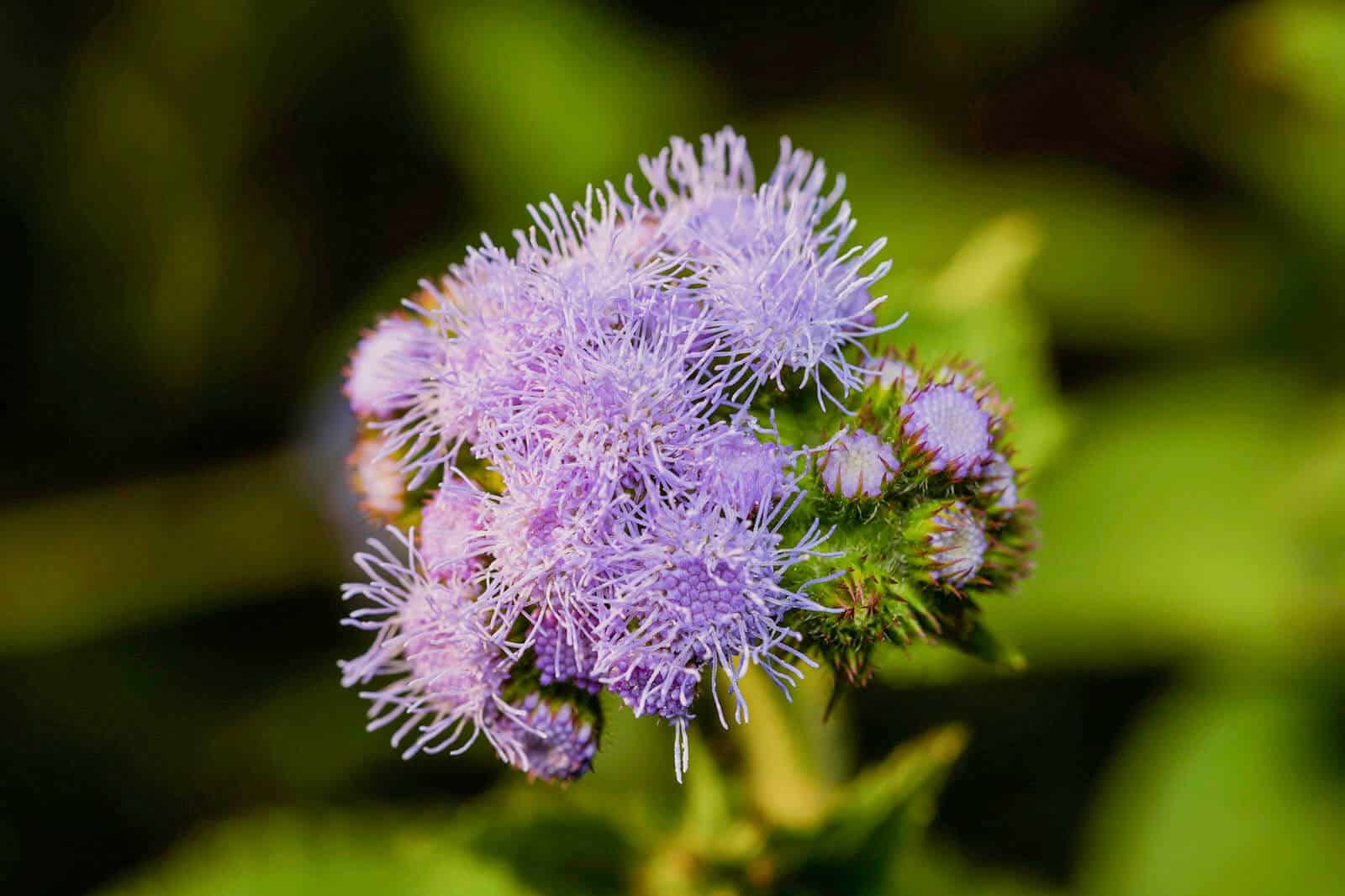
Floss Flower (Ageratum houstonianum) is an annual herbaceous plant known for its fluffy, button-like flower heads in shades of blue, purple, pink, or white.
The flowers are clustered above soft, heart-shaped leaves, creating a delicate and whimsical appearance. Floss Flower is popular for borders, rock gardens, and containers.
- Origin: Floss Flower is native to Mexico and Central America.
- Blooming Month: Floss Flower typically blooms from summer through fall, from June to October.
- Height: Floss Flower plants can grow 6 to 18 inches tall, depending on the variety and growing conditions.
- Care: Floss Flowers prefer full sun to partial shade and well-drained soil. Once established, they are relatively low-maintenance and drought-tolerant. Deadhead the flowers regularly to encourage continuous blooming.
- Uses: Floss Flower is primarily used as an ornamental plant in gardens, borders, and containers. They are also used as cut flowers in floral arrangements.
- Benefits: Floss Flower attracts butterflies and other pollinators to the garden, helping to support local ecosystems.
Fun Facts
- The genus name “Ageratum” comes from the Greek word “ageros,” meaning non-aging, referring to the long-lasting nature of the flowers.
- Floss Flower is often used as a natural dye, producing shades of blue and purple.
- In some cultures, Floss Flower is believed to have medicinal properties and is used to treat fever, wounds, and skin conditions.
9. Fritillaria
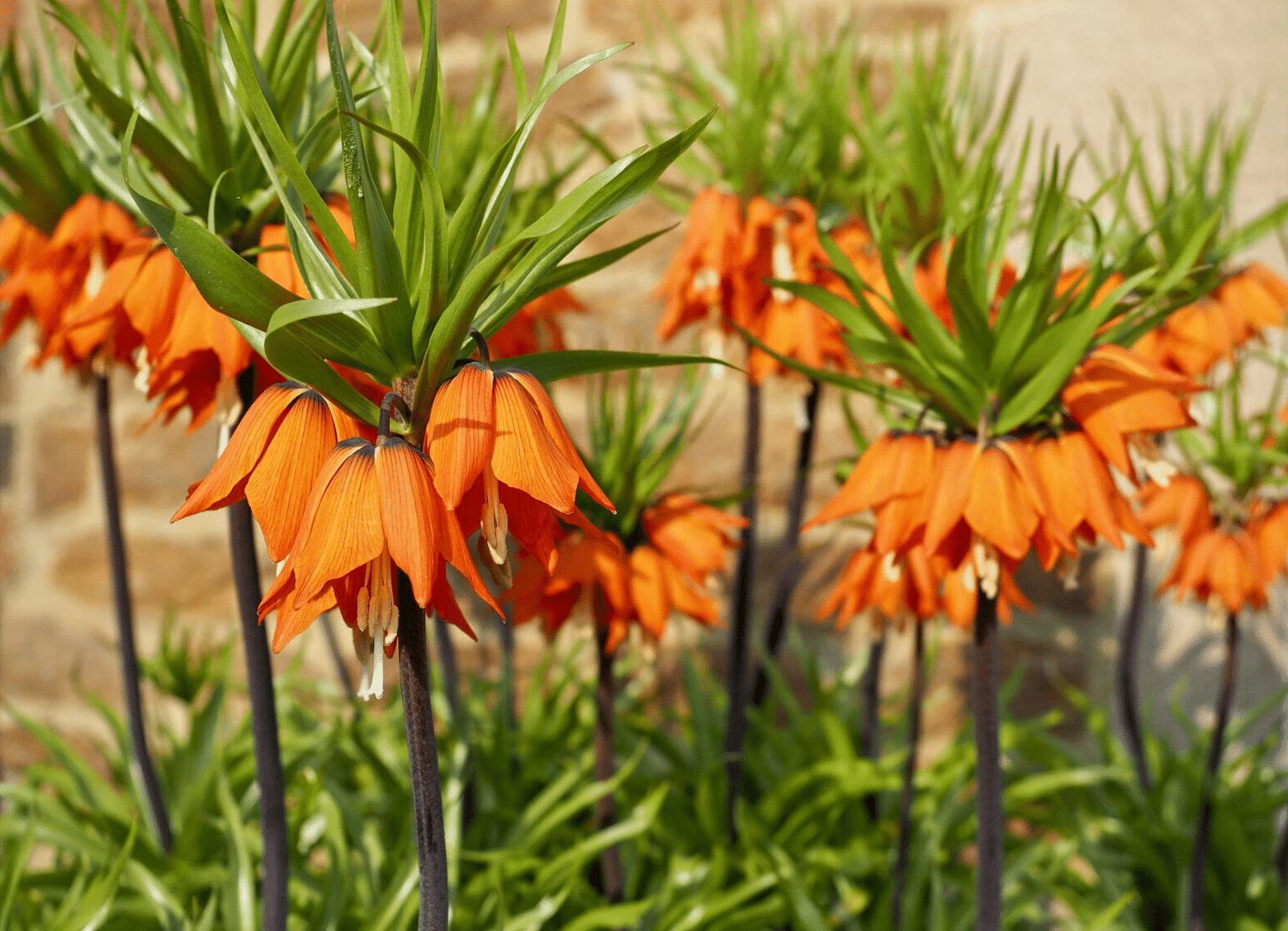
Fritillaria is a genus of bulbous perennial plants known for their nodding, bell-shaped flowers in a variety of colors, including yellow, orange, red, purple, and white.
Many species have checkered or mottled patterns on their petals, adding to their unique appearance. Fritillaria plants have slender stems and narrow, lance-shaped leaves.
- Origin: Fritillaria species are native to the temperate regions of the Northern Hemisphere, including Europe, Asia, and North America.
- Blooming Month: Fritillaria typically blooms in spring, from March to May, depending on the species and region.
- Height: Fritillaria plants can vary in height, ranging from 4 inches to 4 feet tall, depending on the species.
- Care: Fritillaria prefers well-drained soil and partial shade to full sun, depending on the species. They benefit from a layer of mulch to keep the soil cool and moist. Allow the foliage to die back naturally after flowering to ensure the bulb stores enough energy for the next season.
- Uses: Fritillaria is primarily used as an ornamental plant in gardens, rock gardens, and woodland settings. Some species are also used in cut flower arrangements.
- Benefits: Fritillaria bulbs contain compounds that have been used in traditional medicine to treat various ailments, such as coughs, asthma, and tumors.
Fun Facts
- The name “Fritillaria” comes from the Latin word “fritillus,” meaning dice box, referring to the checkered pattern on the petals of some species.
- The Crown Imperial (Fritillaria imperialis) is one of the most impressive species, with tall stems bearing clusters of large, orange or yellow flowers.
- In Chinese medicine, the bulbs of certain Fritillaria species, such as F. cirrhosa and F. thunbergii, are used to treat respiratory disorders and are known as “Chuan Bei Mu” and “Zhe Bei Mu,” respectively.
10. Fringed Orchid
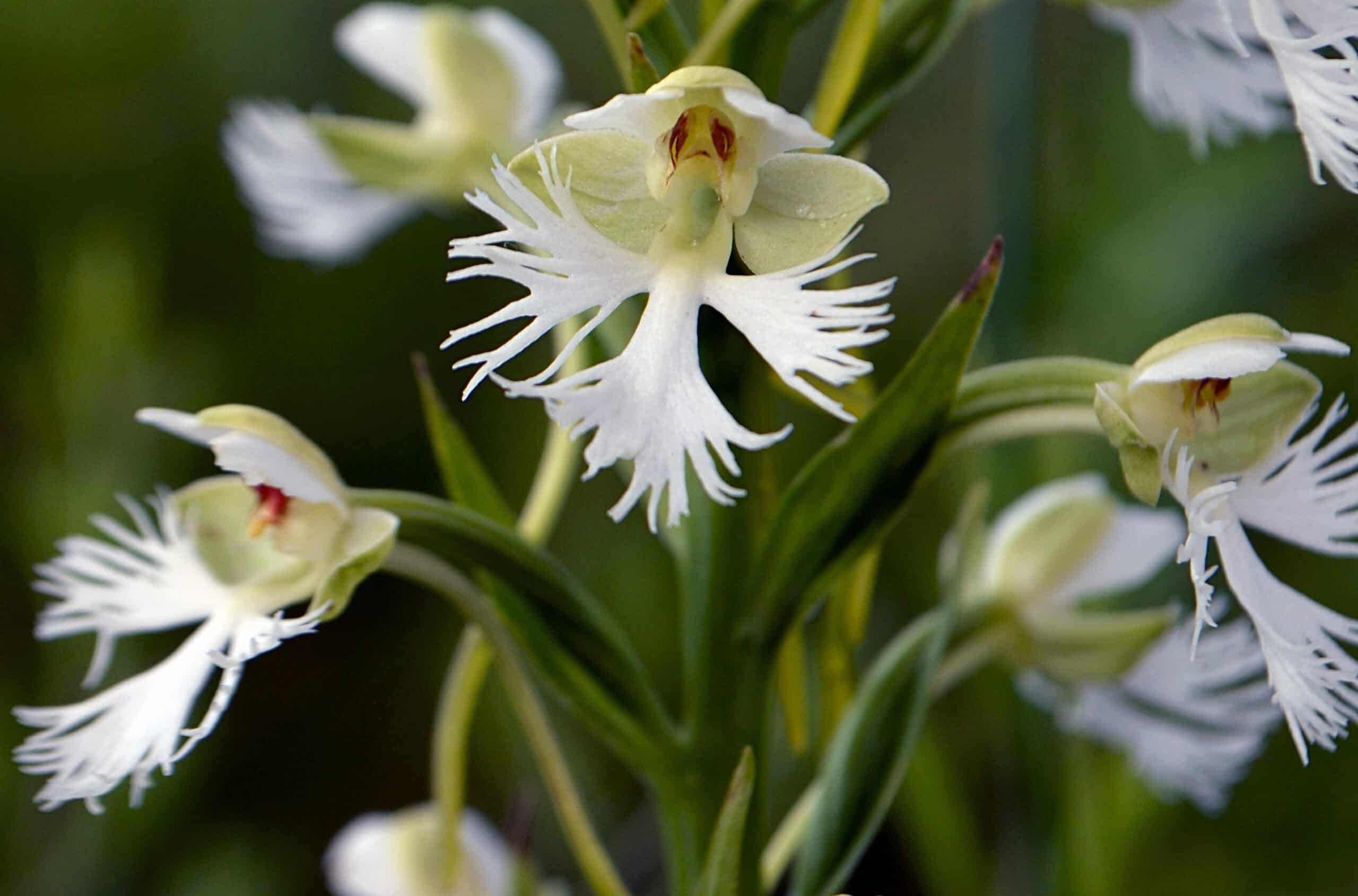
Fringed Orchid (Platanthera) is a genus of terrestrial orchids known for their showy, fringed flowers in shades of white, green, yellow, orange, or purple.
The flowers are arranged on tall spikes and have a distinctive shape, with a fringed lip and a long nectar spur. Fringed Orchids have slender stems and long, narrow leaves.
- Origin: Fringed Orchids are native to the temperate and cool regions of the Northern Hemisphere, including North America, Europe, and Asia.
- Blooming Month: Fringed Orchids typically bloom from late spring to summer, from May to August, depending on the species and region.
- Height: Fringed Orchid plants can vary in height, ranging from 6 inches to 4 feet tall, depending on the species.
- Care: Fringed Orchids prefer moist, well-drained soil and partial shade to full sun, depending on the species. They have specific growing requirements and are best left undisturbed in their natural habitats. In cultivation, they require careful attention to soil moisture and nutrition.
- Uses: Fringed Orchids are primarily appreciated for their ornamental value in natural settings, such as meadows, bogs, and woodlands. They are also used in wildflower gardens and naturalistic plantings.
- Benefits: Fringed Orchids play a vital role in their native ecosystems, serving as a food source for various pollinator species, including bees, butterflies, and moths.
Fun Facts
- The fringed lip of the Fringed Orchid flowers is believed to guide pollinators to the nectar spur, ensuring efficient pollination.
- Some Fringed Orchid species, such as the Eastern Prairie Fringed Orchid (Platanthera leucophaea), are endangered due to habitat loss and are protected by law.
- Native American tribes, such as the Menominee and Ojibwe, have used certain Fringed Orchid species for medicinal purposes, including treating eye infections and headaches.
11. Four O’Clock Flower
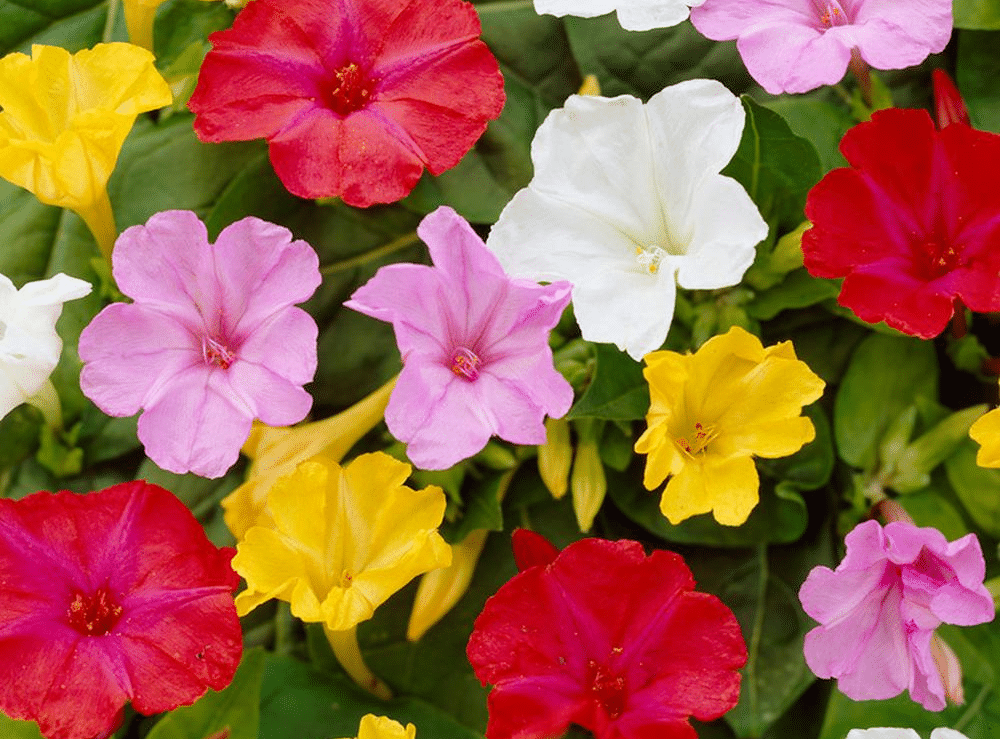
Four O’Clock Flower (Mirabilis jalapa) is a perennial plant known for its vibrant, trumpet-shaped flowers that open in the late afternoon or evening, hence the name “Four O’Clock.”
The flowers come in a wide range of colors, including pink, red, yellow, white, and bicolor. Four O’Clock Flower plants have a bushy, mounding habit and large, heart-shaped leaves.
- Origin: Four O’Clock Flower is native to the tropical regions of South America, particularly Peru.
- Blooming Month: Four O’Clock Flower typically blooms from summer through fall, from June to October.
- Height: Four O’Clock Flower plants can grow between 2 to 4 feet tall and wide, depending on the growing conditions.
- Care: Four O’Clock Flower prefers full sun to partial shade and well-drained soil. They are relatively low-maintenance and drought-tolerant once established. Deadhead the flowers regularly to encourage continuous blooming and prevent self-seeding.
- Uses: Four O’Clock Flower is primarily used as an ornamental plant in gardens, borders, and containers. They make attractive additions to evening gardens and moon gardens.
- Benefits: Four O’Clock Flower has been used in traditional medicine to treat various ailments, such as inflammation, constipation, and skin conditions. The roots contain a compound called mirabilis, which has antibacterial properties.
Fun Facts
- The flowers of Four O’Clock Flower are sensitive to light and temperature changes, opening in the late afternoon when the temperature drops and the light intensity decreases.
- Four O’Clock Flower is also known as “Marvel of Peru,” referring to its native origin and its marvelous flowers.
- In some cultures, the Four O’Clock Flower is associated with timekeeping, as the flowers consistently open and close at specific times of the day.
12. False Indigo
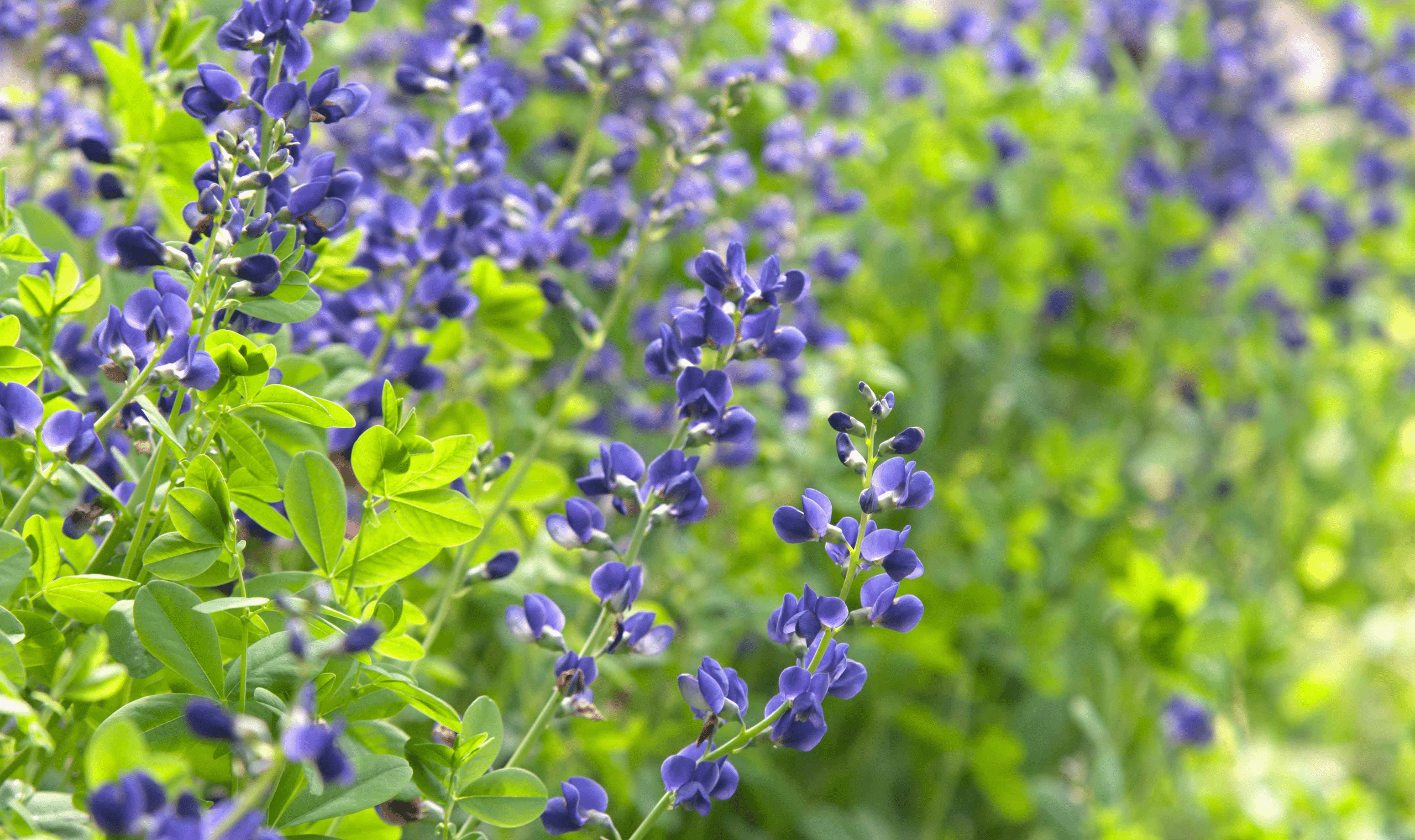
False Indigo (Baptisia) is a genus of herbaceous perennial plants known for their showy, pea-like flowers in shades of blue, purple, yellow, or white.
The flowers are arranged on tall spikes above attractive, blue-green foliage. False Indigo plants have a sturdy, upright growth habit and develop deep taproots.
- Origin: False Indigo species are native to North America, primarily found in the eastern and central United States.
- Blooming Month: False Indigo typically blooms from late spring to early summer, from May to June.
- Height: False Indigo plants can grow between 2 to 4 feet tall and wide, depending on the species and growing conditions.
- Care: False Indigo prefers full sun to partial shade and well-drained soil. They are drought-tolerant once established and have few pest or disease problems. Cut back the foliage in late fall to maintain a tidy appearance.
- Uses: False Indigo is primarily used as an ornamental plant in gardens, borders, and naturalistic plantings. They make excellent additions to cottage gardens, wildflower gardens, and native plant gardens.
- Benefits: False Indigo plants are nitrogen-fixing, meaning they have a symbiotic relationship with bacteria that convert atmospheric nitrogen into a form that plants can use, improving soil fertility.
Fun Facts
- The common name “False Indigo” refers to the use of some Baptisia species as a substitute for true indigo (Indigofera) in the production of blue dye.
- False Indigo is an important host plant for the larvae of several butterfly species, including the Wild Indigo Duskywing and the Frosted Elfin.
- Native American tribes, such as the Cherokee and Osage, have used False Indigo for medicinal purposes, including treating fever, diarrhea, and respiratory ailments.
13. Feather Celosia
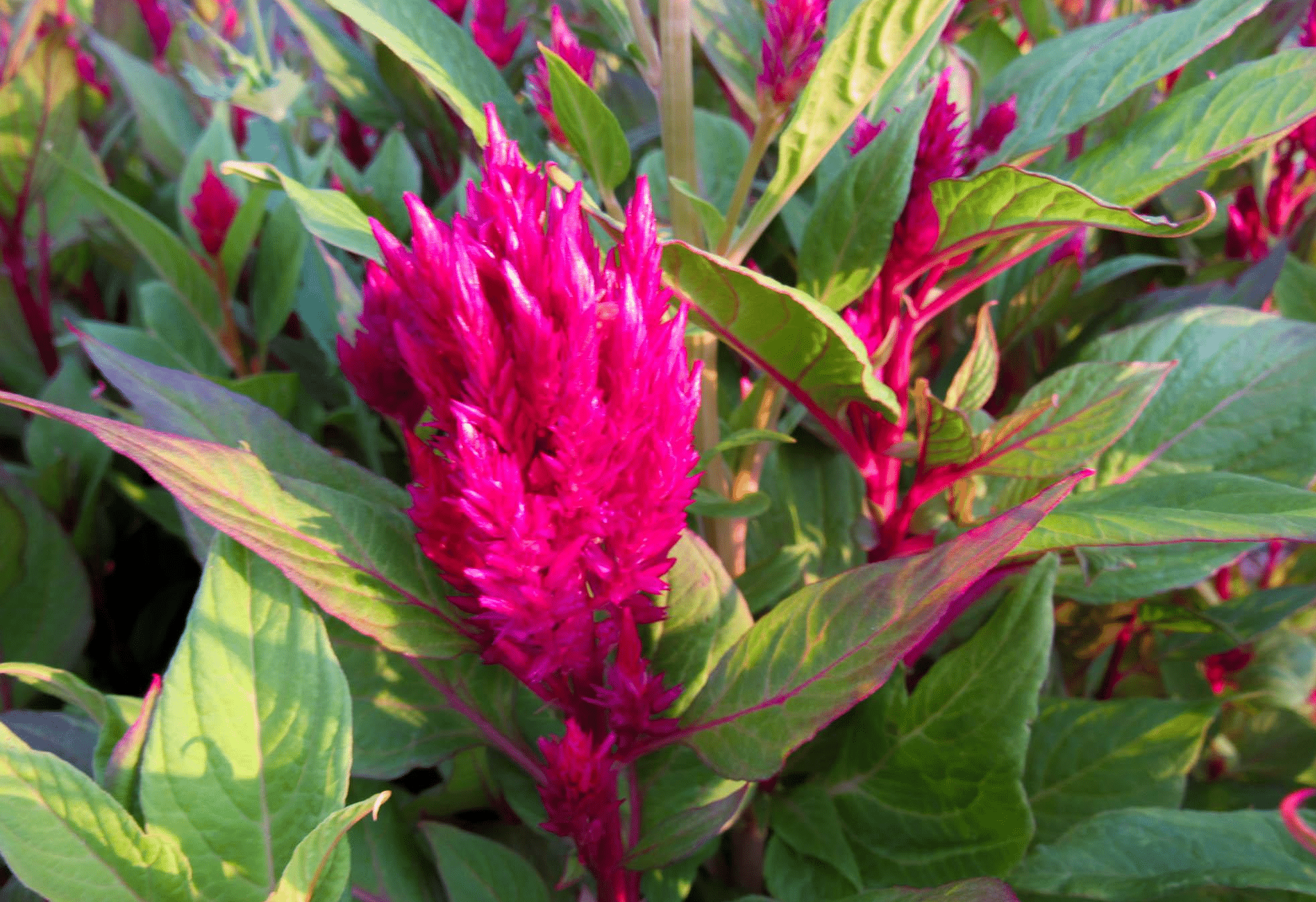
Feather Celosia (Celosia argentea var. plumosa) is an annual plant known for its striking, feathery flower plumes in vibrant shades of red, orange, yellow, pink, and purple.
The soft, fluffy plumes are composed of numerous tiny flowers and rise above the plant’s oval, green leaves. Feather Celosia adds texture and color to gardens and flower arrangements.
- Origin: Feather Celosia is native to the tropical regions of Africa, Asia, and South America.
- Blooming Month: Feather Celosia typically blooms from summer through fall, from June to October.
- Height:
Feather Celosia plants can grow between 6 inches – 3 feet tall, depending on the variety and growing conditions. - Care: Feather Celosia prefers full sun and well-drained soil. They are heat-tolerant and relatively low-maintenance, requiring regular watering and occasional fertilization. Deadhead the flowers to encourage continuous blooming and maintain a tidy appearance.
- Uses: Feather Celosia is primarily used as an ornamental plant in gardens, borders, and containers. They make excellent cut flowers and are popular in dried flower arrangements.
- Benefits: Feather Celosia attracts butterflies and other pollinators to the garden, providing a food source and supporting local ecosystems.
Fun Facts
- Feather Celosia is also known as “Plumed Cockscomb” or “Prince of Wales Feathers,” referring to the shape and appearance of its flower plumes.
- In some cultures, Feather Celosia is associated with immortality and is used in religious ceremonies and offerings.
- The seeds of Feather Celosia are edible and are sometimes used as a grain substitute or added to soups and stews.
14. French Marigold
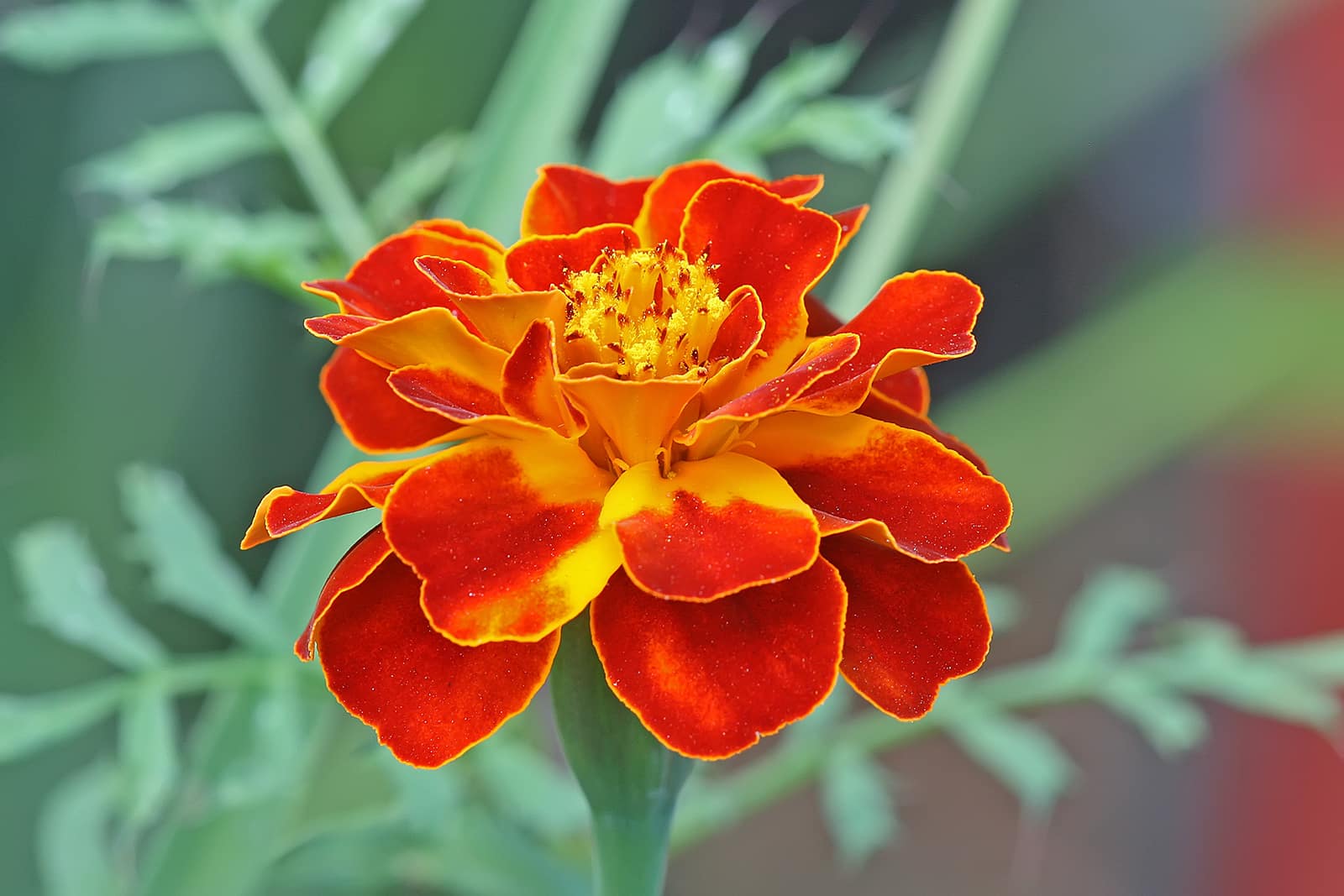
French Marigold (Tagetes patula) is an annual plant known for its compact, bushy growth habit and vibrant, double flower heads in shades of yellow, orange, and red.
The flowers have a pom-pom-like appearance and are held above the plant’s finely divided, aromatic foliage. French Marigolds add a pop of color to gardens and containers.
- Origin: French Marigold is native to Mexico and Central America.
- Blooming Month: French Marigold typically blooms from summer through fall, from June to October.
- Height: French Marigold plants can grow between 6 to 12 inches tall and wide, depending on the variety and growing conditions.
- Care: French Marigold prefers full sun and well-drained soil. They are relatively low-maintenance, drought-tolerant, and pest-resistant. Deadhead the flowers regularly to encourage continuous blooming and maintain a tidy appearance.
- Uses: French Marigold is primarily used as an ornamental plant in gardens, borders, and containers.
Fun Facts
- French Marigold is not actually native to France; the name is believed to have originated from its use in French gardens.
- The Aztecs used French Marigold in religious ceremonies and as a medicinal plant, calling it “cempoalxochitl,” meaning “twenty flowers” in Nahuatl.
- French Marigold is often used as a natural dye, producing shades of yellow and orange. The flowers are also edible and can be used to add color and flavor to salads and other dishes.
15. Florist’s Cineraria
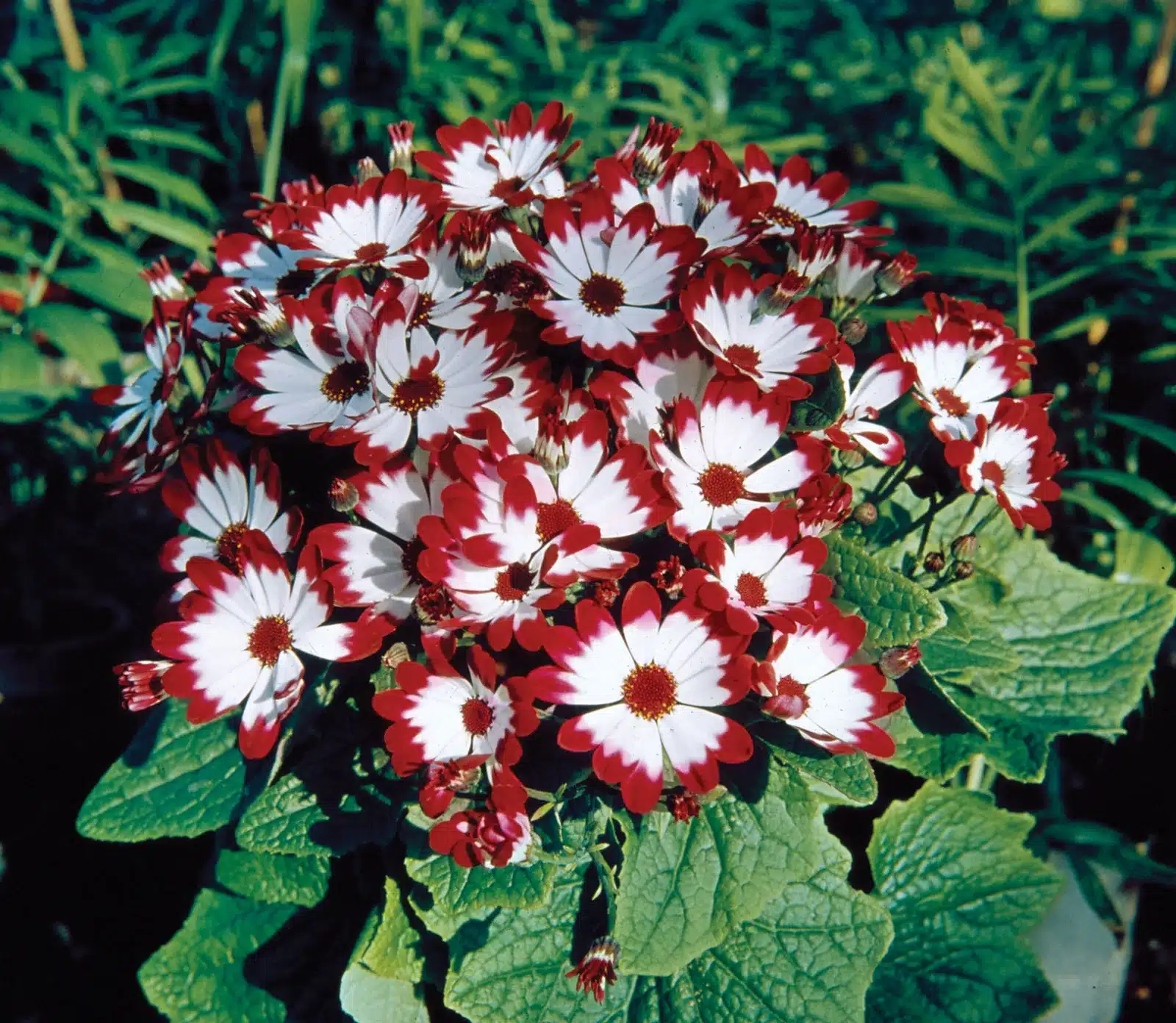
Florist’s Cineraria (Pericallis x hybrida) is a flowering plant known for its large, daisy-like flowers in a wide range of vibrant colors, including purple, blue, pink, red, and white.
The flowers are held above large, heart-shaped leaves that are often covered in a soft, silvery down. Florist’s Cineraria is popular as a houseplant and in cool-season gardens.
- Origin: Florist’s Cineraria is a hybrid species developed from plants native to the Canary Islands.
- Blooming Month: Florist’s Cineraria typically blooms from late winter to early spring, from February to April.
- Height: Florist’s Cineraria plants can grow between 8 to 18 inches tall and wide, depending on the variety and growing conditions.
- Care: Florist’s Cineraria prefers cool temperatures, partial shade, and well-drained soil. They require regular watering and fertilization during the growing season. Remove spent flowers to maintain a tidy appearance and encourage continuous blooming.
- Uses: Florist’s Cineraria is primarily used as an ornamental plant in cool-season gardens, containers, and as a houseplant. They make attractive additions to indoor flower arrangements.
- Benefits: Florist’s Cineraria adds color and interest to indoor spaces during the winter months when outdoor plants are dormant.
Fun Facts
- The genus name “Pericallis” comes from the Greek words “peri,” meaning around, and “kallos,” meaning beauty, referring to the attractive appearance of the flowers.
- Florist’s Cineraria has been awarded the Royal Horticultural Society’s Award of Garden Merit, recognizing its outstanding performance and reliability.
- In the Victorian language of flowers, cineraria symbolizes a small act of kindness or a delicate feeling of affection.
16. Flowering Maple
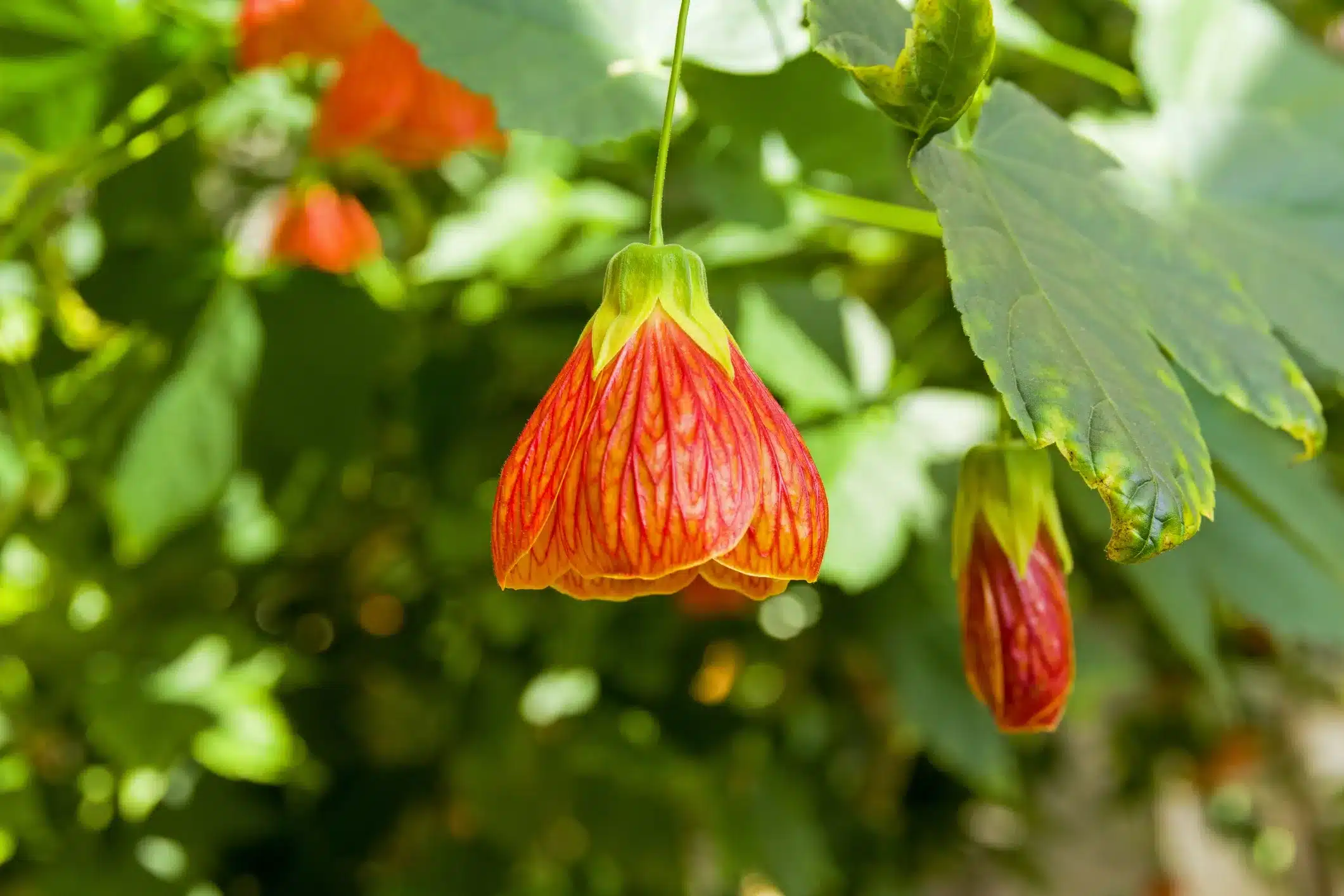
Flowering Maple (Abutilon) is a genus of evergreen shrubs known for their maple-like leaves and showy, bell-shaped flowers in shades of yellow, orange, red, pink, and white.
The flowers have a papery texture and are often veined or streaked with contrasting colors. Flowering Maple plants have a bushy, upright growth habit and can be grown as houseplants or in outdoor gardens in warm climates.
- Origin: Flowering Maple species are native to the tropical and subtropical regions of South America, Africa, and Asia.
- Blooming Month: Flowering Maple can bloom year-round in tropical climates, with peak blooming occurring from summer to fall.
- Height: Flowering Maple plants can grow between 3 to 8 feet tall and wide, depending on the species and growing conditions.
- Care: Flowering Maple prefers full sun to partial shade and well-drained soil. They benefit from regular watering and fertilization during the growing season. Prune the plant regularly to maintain its shape and encourage bushier growth.
- Uses: Flowering Maple is primarily used as an ornamental plant in gardens, containers, and as a houseplant. They make attractive additions to hanging baskets and patio displays.
- Benefits: Flowering Maple attracts hummingbirds and butterflies to the garden, providing a food source and supporting local ecosystems.
Fun Facts
- The common name “Flowering Maple” refers to the plant’s maple-like leaves, although it is not related to true maple trees (Acer).
- In traditional Chinese medicine, certain Flowering Maple species, such as A. indicum, have been used to treat various ailments, including fever, cough, and diarrhea.
- Flowering Maple is also known as “Chinese Lantern” or “Indian Mallow,” referring to the shape and origin of some species.
17. Fairy Duster
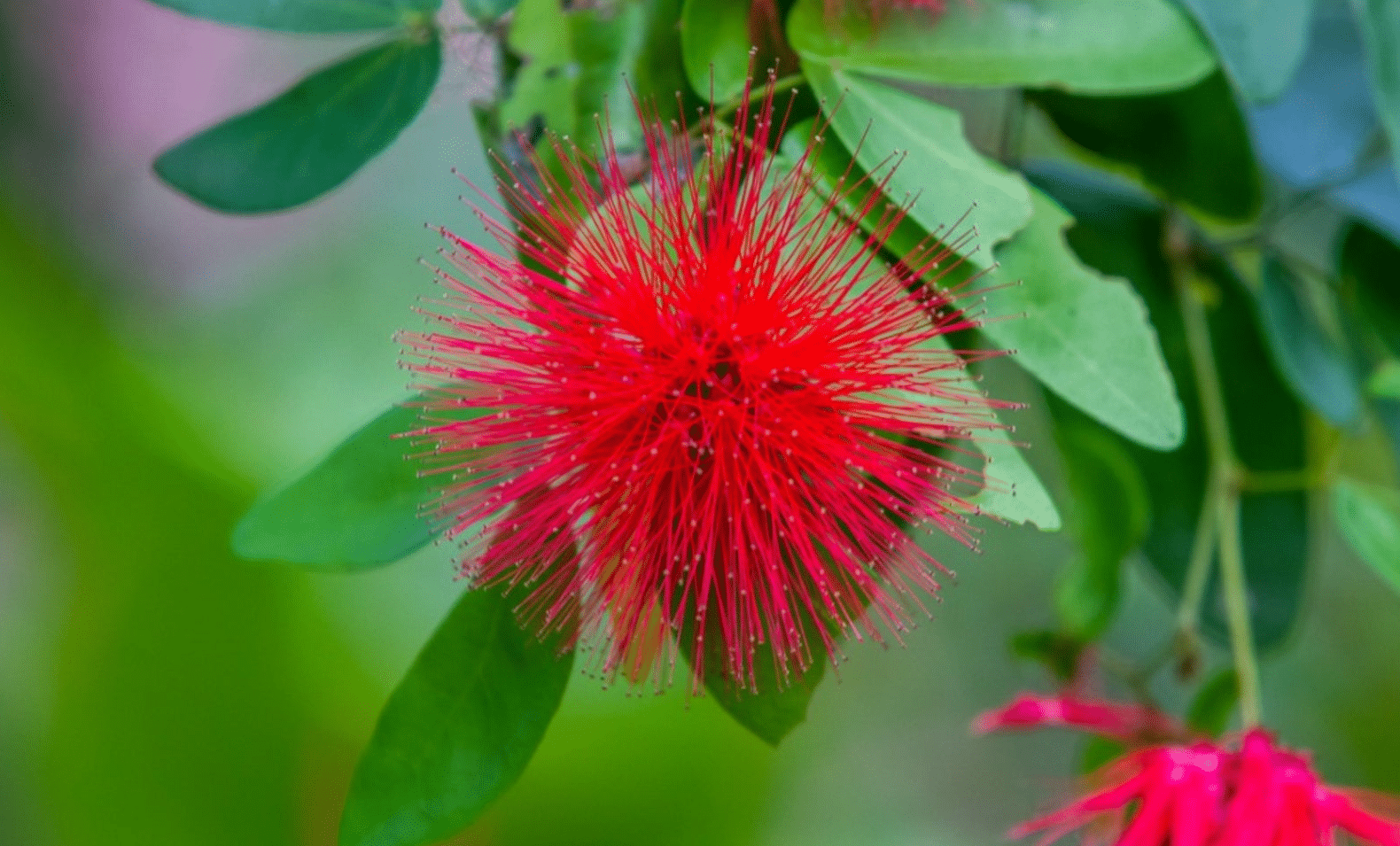
Fairy Duster (Calliandra) is a genus of small shrubs or trees known for their delicate, fluffy flower clusters that resemble miniature dusters or brushes.
The flowers are composed of numerous long, slender stamens in shades of red, pink, or white, which extend far beyond the small petals. Fairy Duster plants have bipinnate, fern-like leaves that add to their ornamental appeal.
- Origin: Fairy Duster species are native to the Americas, ranging from the southwestern United States to South America.
- Blooming Month: Fairy Duster can bloom year-round in tropical climates, with peak blooming occurring from spring to summer.
- Height: Fairy Duster plants can grow between 3 to 15 feet tall, depending on the species and growing conditions.
- Care: Fairy Duster prefers full sun to partial shade and well-drained soil. They are drought-tolerant once established and require minimal pruning to maintain their shape. In colder regions, they can be grown as container plants and brought indoors during winter.
- Uses:
Fairy Duster is primarily used as an ornamental plant in gardens, borders, and containers. They make attractive additions to hummingbird and butterfly gardens. - Benefits: Fairy Duster plants are nitrogen-fixing, meaning they have a symbiotic relationship with bacteria that convert atmospheric nitrogen into a form that plants can use, improving soil fertility.
Fun Facts
- The genus name “Calliandra” comes from the Greek words “kallos,” meaning beautiful, and “andros,” meaning male, referring to the showy stamens of the flowers.
- Some Fairy Duster species, such as C. eriophylla, are used in traditional Native American medicine to treat various ailments, including skin infections and digestive issues.
- Fairy Duster flowers are highly attractive to hummingbirds and butterflies, making them popular choices for wildlife gardens.
18. Ficus
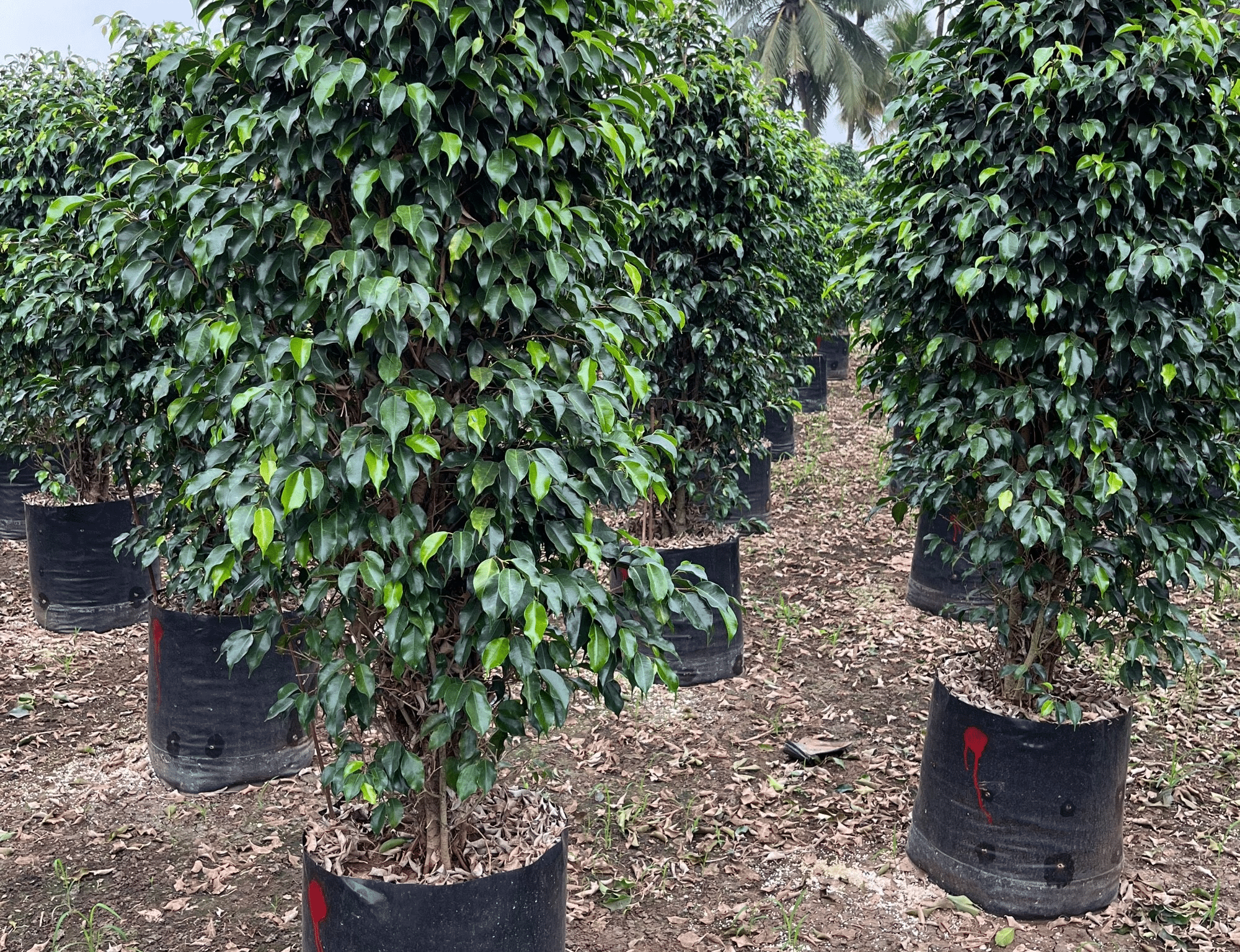
Ficus is a large genus of evergreen trees, shrubs, and vines known for their glossy, leathery leaves and unique flowering and fruiting structures.
Many Ficus species have aerial roots and can grow as epiphytes or stranglers in their native habitats. The most well-known species is the Ficus benjamina, commonly grown as an indoor houseplant.
- Origin: Ficus species are native to tropical and subtropical regions worldwide, with a high diversity in Asia and Australasia.
- Blooming Month: Ficus plants have unique flowering and fruiting structures called syconia, which are hollow receptacles containing numerous tiny flowers. The flowering and fruiting time varies among species and can occur year-round in tropical climates.
- Height: Ficus plants can vary greatly in height, ranging from small shrubs to large trees that can reach over 100 feet tall in their native habitats.
- Care: Ficus plants prefer bright, indirect light and well-drained soil. They benefit from regular watering and high humidity, making them suitable for indoor growth. Pruning can be done to control their size and shape.
- Uses: Ficus plants are popular ornamental plants in indoor and outdoor landscaping. Some species, such as Ficus carica (common fig), are grown for their edible fruit.
- Benefits: Ficus plants are known for their air-purifying abilities, removing toxins such as formaldehyde and benzene from indoor environments.
Fun Facts
- The Bodhi tree, under which the Buddha is said to have attained enlightenment, is a species of Ficus (Ficus religiosa).
- Ficus plants have a symbiotic relationship with tiny wasps that pollinate the flowers within the syconia and lay their eggs inside.
- The Ficus genus includes the banyan tree (Ficus benghalensis), which has a unique growth habit, sending down aerial roots that grow into additional trunks, forming large, sprawling canopies.
19. Flamingo Lily
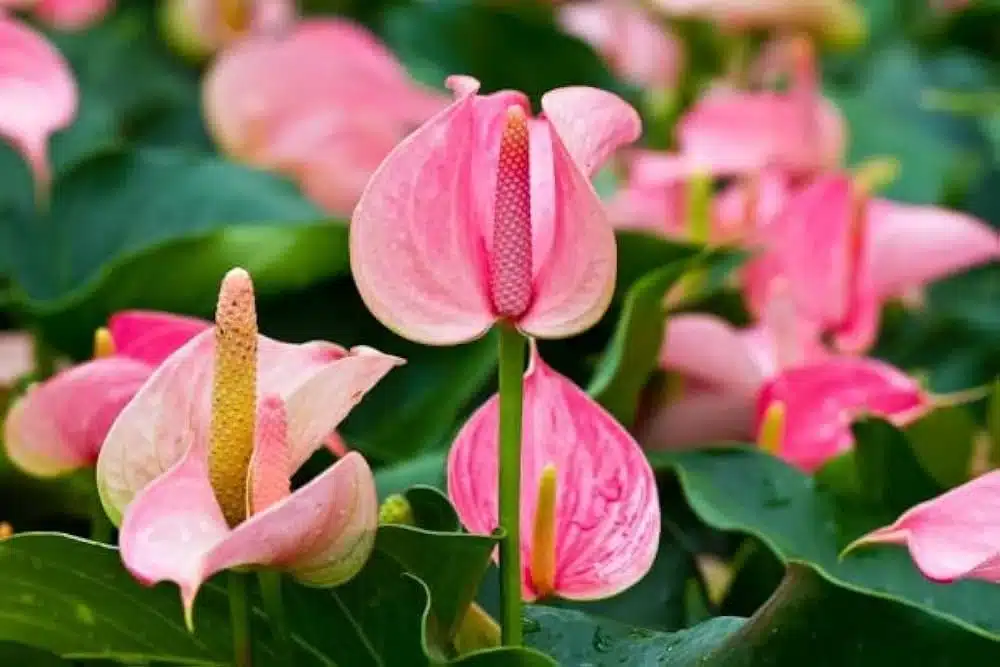
Flamingo Lily (Anthurium) is a genus of evergreen, herbaceous plants known for their distinctive, glossy, heart-shaped leaves and long-lasting, waxy flowers.
The flowers consist of a colorful spathe, which is a modified leaf that surrounds a slender, spike-like spadix. Flamingo Lilies come in a range of colors, including red, pink, orange, and white.
- Origin: Flamingo Lily species are native to the tropical regions of Central and South America.
- Blooming Month: Flamingo Lilies can bloom year-round under the right conditions, with each flower lasting for several weeks to months.
- Height: Flamingo Lily plants can vary in height, depending on the species and growing conditions, ranging from 12 inches to 3 feet tall.
- Care: Flamingo Lilies prefer bright, indirect light and well-drained slightly acidic soil. They require moderate watering and benefit from high humidity, making them suitable for indoor growth. Remove any dead or yellowing leaves to maintain the plant’s appearance.
- Uses: Flamingo Lilies are popular ornamental plants, grown for their attractive foliage and long-lasting flowers. They are commonly used in floral arrangements and as houseplants.
- Benefits: Flamingo Lilies are known for their air-purifying qualities, removing indoor pollutants such as formaldehyde, ammonia, and xylene.
Fun Facts
- The name “Anthurium” comes from the Greek words “anthos,” meaning flower, and “oura,” meaning tail, referring to the plant’s tail-like spadix.
- Flamingo Lilies are not true lilies; they belong to the Araceae family, which includes other popular houseplants like peace lilies and philodendrons.
- In the wild, Flamingo Lilies are pollinated by hummingbirds and other nectar-seeking birds, which are attracted to the bright colors and nectar-rich flowers.
20. Foxglove Beard Tongue
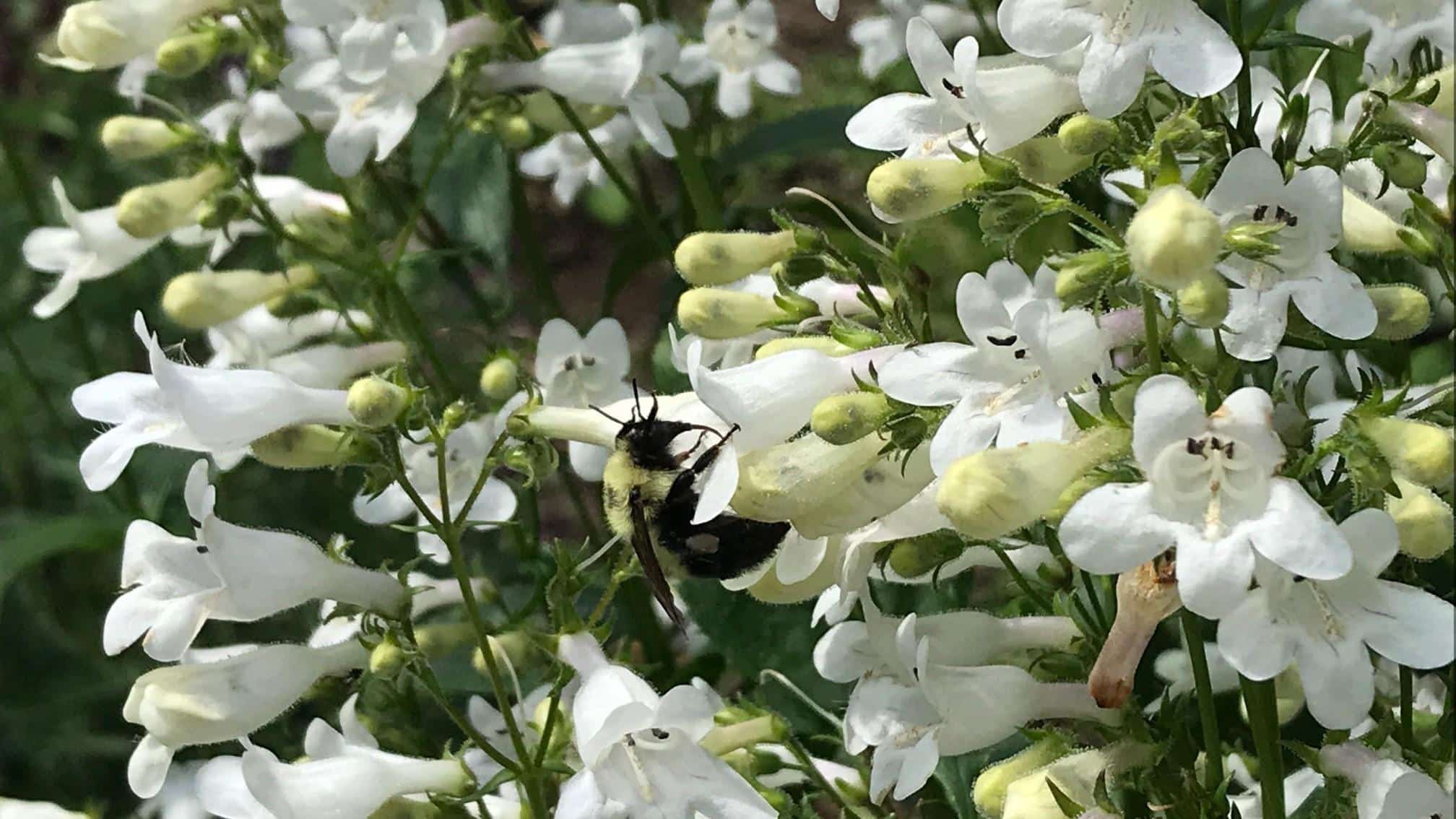
Foxglove Beard Tongue (Penstemon digitalis) is a perennial plant known for its tall spikes of tubular, white to light pink flowers that resemble miniature foxgloves.
The flowers have five lobes and are arranged in pairs along the upper portion of the stem. Foxglove Beard Tongue has glossy, lance-shaped leaves that are deep green in color.
- Origin: Foxglove Beard Tongue is native to the eastern United States, from Maine to Georgia and west to the Mississippi River.
- Blooming Month: Foxglove Beard Tongue typically blooms from late spring to early summer, from May to July.
- Height: Foxglove Beard Tongue plants can grow between 2 to 4 feet tall, depending on the growing conditions.
- Care: Foxglove Beard Tongue prefers full sun to partial shade and well-drained soil. They are relatively low-maintenance and tolerant of a wide range of soil types. Deadheading spent flowers can encourage a longer blooming period.
- Uses: Foxglove Beard Tongue is primarily used as an ornamental plant in gardens, borders, and naturalized areas. They make excellent additions to pollinator gardens and wildlife habitats.
- Benefits: Foxglove Beard Tongue attracts a variety of pollinators, including bees, butterflies, and hummingbirds, providing a valuable food source and supporting local ecosystems.
Fun Facts
- The genus name “Penstemon” comes from the Greek words “pente,” meaning five, and “stemon,” meaning stamen, referring to the five stamens found in the flowers.
- Foxglove Beard Tongue is a popular choice for cut flower arrangements, as the long-lasting blooms hold up well in bouquets.
- Native Americans used Foxglove Beard Tongue for medicinal purposes, including treating heart conditions and respiratory issues, although modern medical use is not recommended without professional guidance.
21. Firecracker Plant
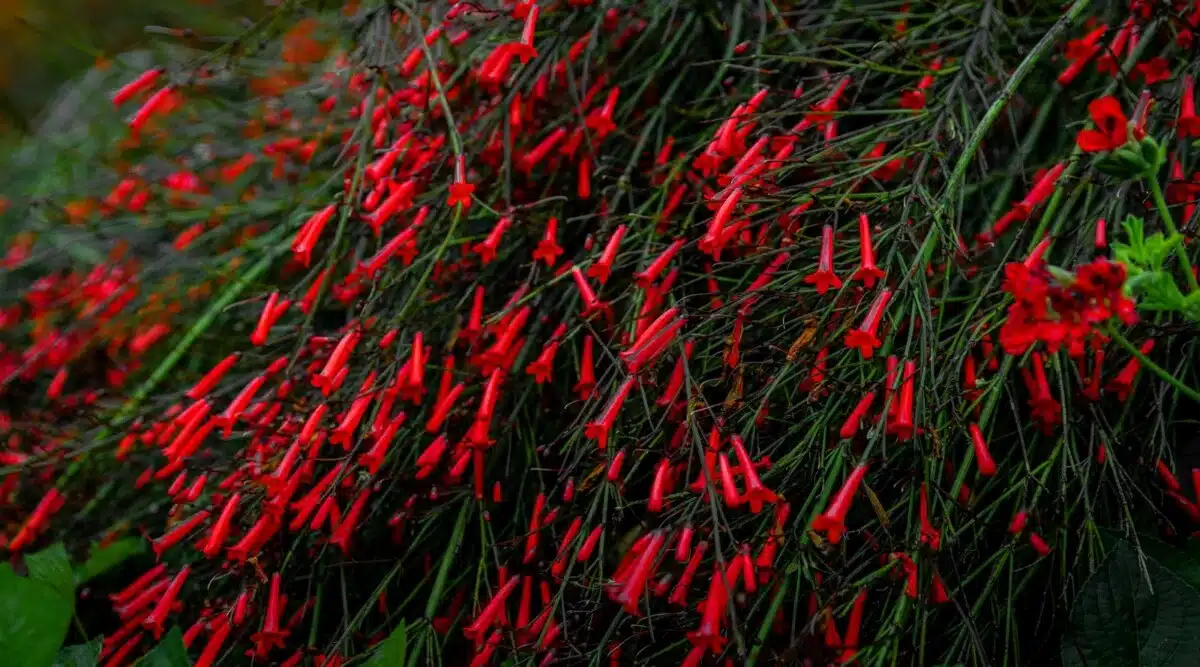
Firecracker Plant (Russelia equisetiformis) is a perennial shrub known for its cascading stems and abundant, tubular, bright red flowers that resemble firecrackers.
The flowers are small and arranged in loose clusters along the thin, arching stems, creating a striking display of color. Firecracker Plant has small, needle-like leaves that give the plant a delicate, airy appearance.
- Origin: Firecracker Plant is native to Mexico and Central America.
- Blooming Month: Firecracker Plant can bloom year-round in tropical and subtropical climates, with peak blooming occurring from spring to fall.
- Height: Firecracker Plant can grow between 2 to 4 feet tall and wide, with its cascading stems often growing longer than the plant’s height.
- Care: Firecracker Plant prefers full sun to partial shade and well-drained soil. They are drought-tolerant once established and require minimal pruning to maintain their shape. In colder regions, they can be grown as annual plants or in containers that can be brought indoors during winter.
- Uses: Firecracker Plant is primarily used as an ornamental plant in gardens, hanging baskets, and containers. They make attractive additions to the hummingbird and butterfly gardens.
- Benefits: Firecracker Plant attracts hummingbirds and butterflies, providing a valuable food source and adding visual interest to gardens.
Fun Facts
- The genus name “Russelia” honors Alexander Russell, an 18th-century Scottish physician and botanist.
- Firecracker Plant is also known as “Coral Plant” or “Fountain Plant,” referring to its cascading growth habit and bright red flowers.
- In some parts of Mexico, the Firecracker Plant is used in traditional medicine to treat various ailments, including skin infections and digestive issues.
22. Firethorn
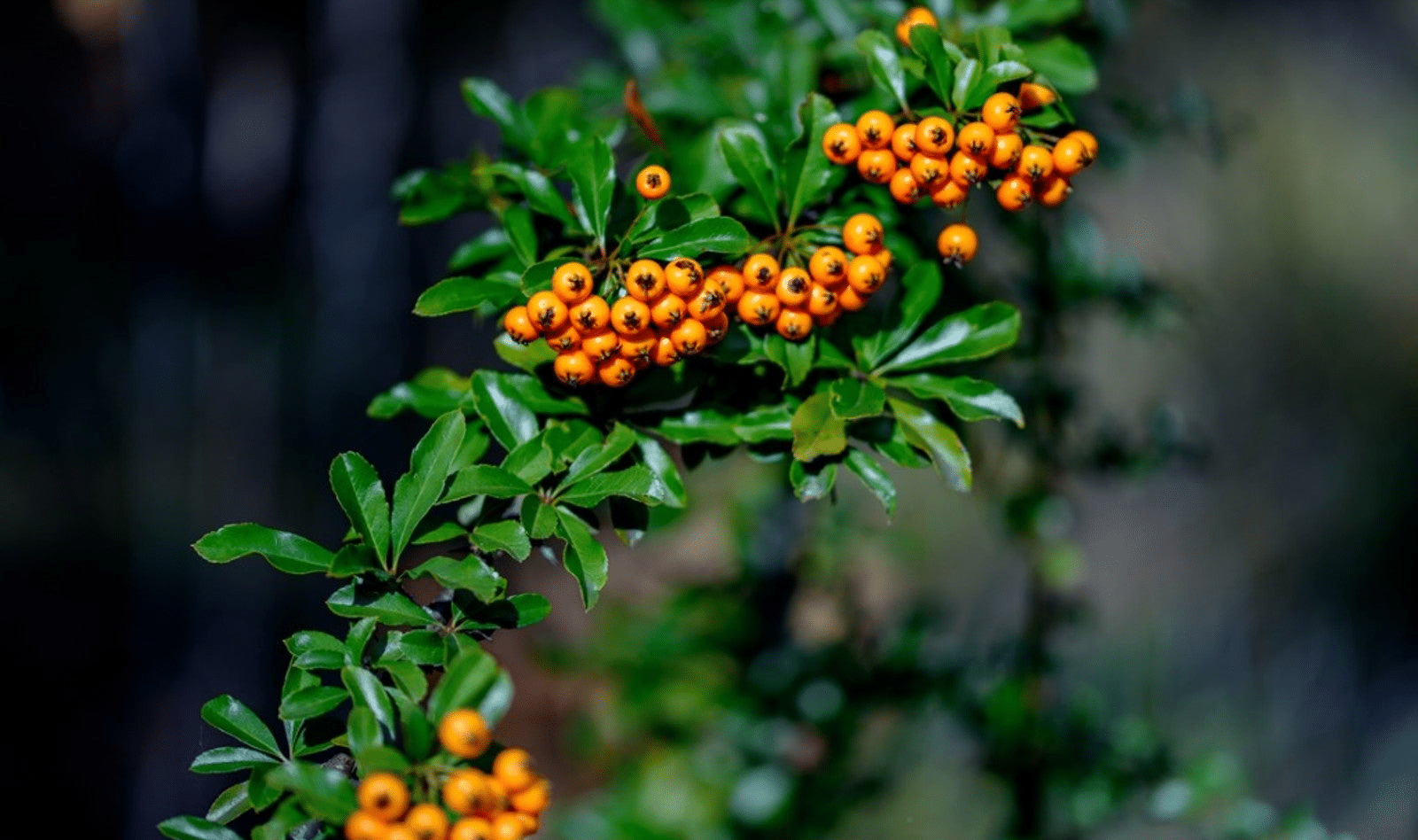
Firethorn (Pyracantha) is a genus of evergreen shrubs known for their dense, spiny branches, small white flowers, and vibrant red, orange, or yellow berries that persist through winter.
The leaves are small, oval-shaped, and glossy, providing a backdrop for the colorful berries. Firethorn plants have a rounded spreading growth habit and can be trained as a hedge, espalier, or wall cover.
- Origin: Firethorn species are native to southern Europe, western Asia, and Southeast Asia.
- Blooming Month: Firethorn typically blooms in late spring to early summer, with clusters of small, white flowers appearing along the branches.
- Height: Firethorn shrubs can grow between 6 to 15 feet tall and wide, depending on the species and growing conditions.
- Care: Firethorn prefers full sun to partial shade and well-drained soil. They are drought-tolerant once established and require minimal pruning to maintain their shape. Regular pruning can help control their size and encourage denser growth.
- Uses: Firethorn is primarily used as an ornamental plant in gardens and hedges and as a barrier plant due to its dense, spiny growth. The colorful berries add winter interest to landscapes and provide a food source for birds.
- Benefits: Firethorn berries are a valuable winter food source for various bird species, helping to sustain wildlife during the colder months.
Fun Facts
- The name “Pyracantha” comes from the Greek words “pyr,” meaning fire, and “akantha,” meaning thorn, referring to the plant’s fiery red berries and thorny stems.
- Firethorn berries are mildly toxic to humans and pets if ingested in large quantities, causing digestive irritation and discomfort.
- In some cultures, Firethorn is associated with protection and safety, with its thorny branches believed to ward off evil spirits and provide a physical barrier against intruders.
23. Fringe Flower
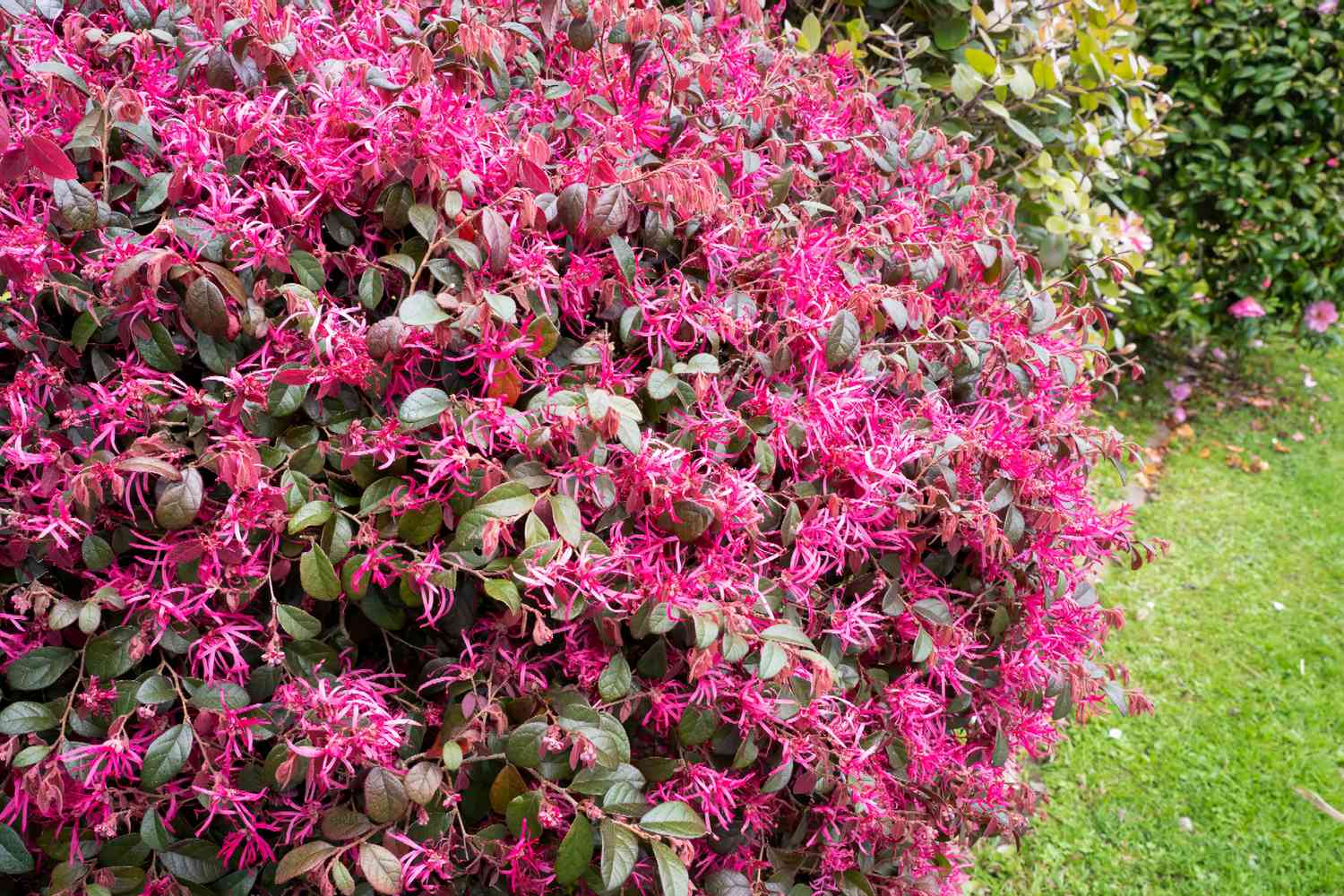
Fringe Flower (Loropetalum chinense) is an evergreen shrub known for its delicate, strap-like petals that give the flowers a fringe-like appearance.
The flowers are small and clustered, ranging in color from white to various shades of pink, red, or purple, depending on the cultivar. Fringe Flower plants have a compact, rounded growth habit with oval, glossy leaves that can be green, bronze, or burgundy.
- Origin: Fringe Flower is native to China, Japan, and the Himalayas.
- Blooming Month: Fringe Flower typically blooms in early spring, from March to April, with occasional repeat blooming throughout the year in milder climates.
- Height: Fringe Flower shrubs can grow between 4 to 10 feet tall and wide, depending on the cultivar and growing conditions.
- Care: Fringe Flower prefers partial shade to full sun and well-drained, acidic soil. They are relatively low-maintenance and drought-tolerant once established. Pruning can be done after flowering to maintain the desired shape and size.
- Uses: Fringe Flower is primarily used as an ornamental plant in gardens, borders, and foundation plantings. They make attractive additions to woodland gardens and can be used as a hedge or screen.
- Benefits: Fringe Flower provides early spring nectar for pollinators, such as bees and butterflies, helping to support local ecosystems.
Fun Facts
- The genus name “Loropetalum” comes from the Greek words “loros,” meaning strap, and “petalon,” meaning petal, referring to the strap-like shape of the flower petals.
- Fringe Flower is a member of the witch hazel family (Hamamelidaceae) and is related to other ornamental shrubs like witch hazel and winter hazel.
- In traditional Chinese medicine, Fringe Flower has been used to treat various ailments, including skin infections, wounds, and hemorrhoids.
24. False Sunflower
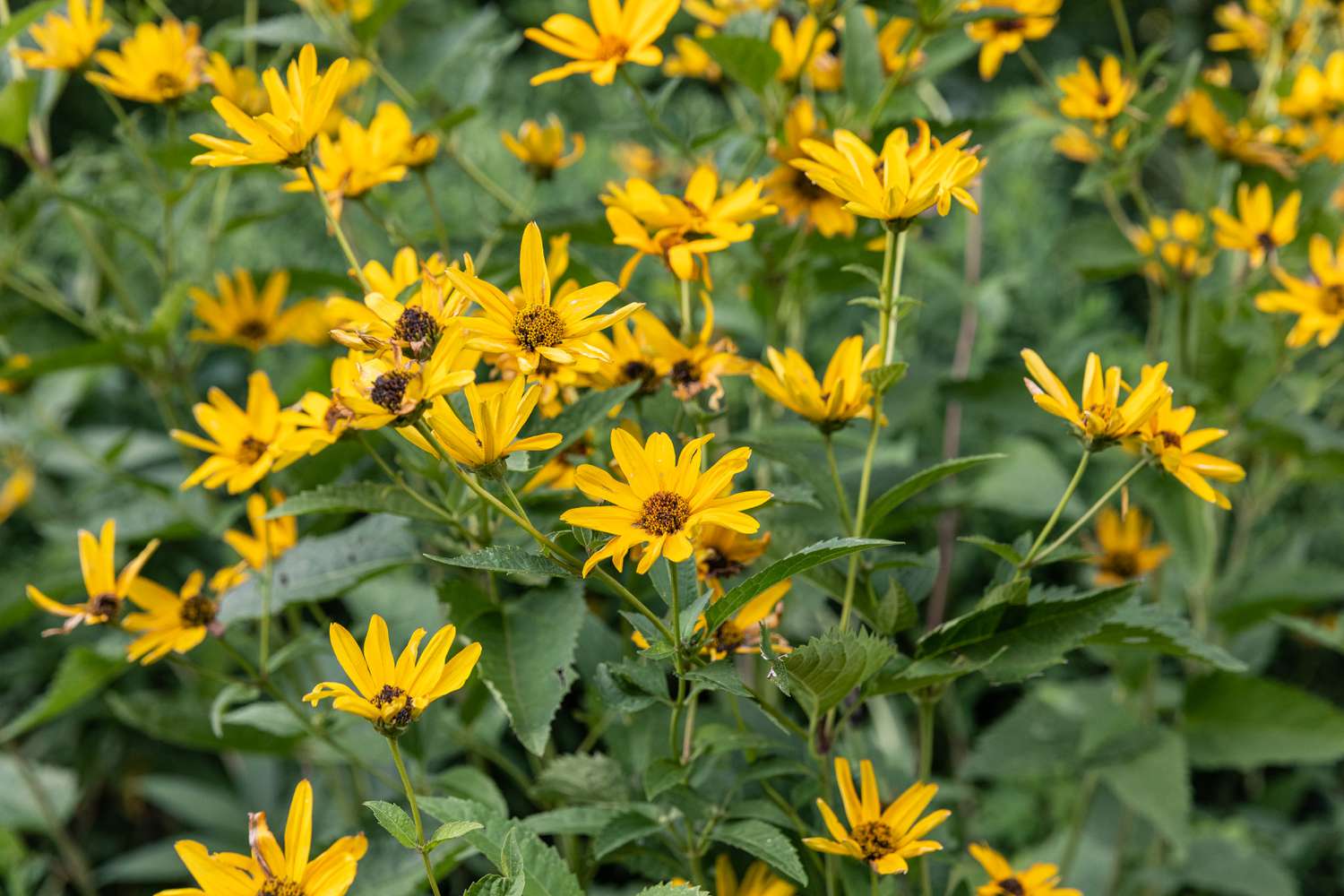
False Sunflower (Heliopsis helianthoides) is a perennial plant known for its sunflower-like flowers with golden-yellow petals surrounding a brownish-yellow center.
The flowers are smaller than true sunflowers and bloom abundantly on sturdy, upright stems. False Sunflower has toothed, oval-shaped leaves that are dark green in color.
- Origin: False Sunflower is native to North America, ranging from southern Canada to the eastern and central United States.
- Blooming Month: False Sunflower typically blooms from mid-summer to early fall, from July to September.
- Height: False Sunflower plants can grow between 3 to 6 feet tall, depending on the cultivar and growing conditions.
- Care: False Sunflower prefers full sun and well-drained soil. They are drought-tolerant and low-maintenance once established. Deadheading spent flowers can encourage prolonged blooming.
- Uses: False Sunflower is primarily used as an ornamental plant in gardens, borders, and naturalized areas. They make excellent cut flowers and attract pollinators to the garden.
- Benefits: False Sunflower provides nectar and pollen for bees, butterflies, and other beneficial insects, supporting local ecosystems.
Fun Facts
- The genus name “Heliopsis” comes from the Greek words “helios,” meaning sun, and “opsis,” meaning appearance, referring to the sunflower-like appearance of the flowers.
- False Sunflower is also known as “Ox-eye” or “Orange Sunflower,” due to its resemblance to sunflowers and the orange-yellow color of its petals.
- Native Americans used False Sunflower for various medicinal purposes, including treating snake bites, fevers, and skin conditions.
25. Fittonia
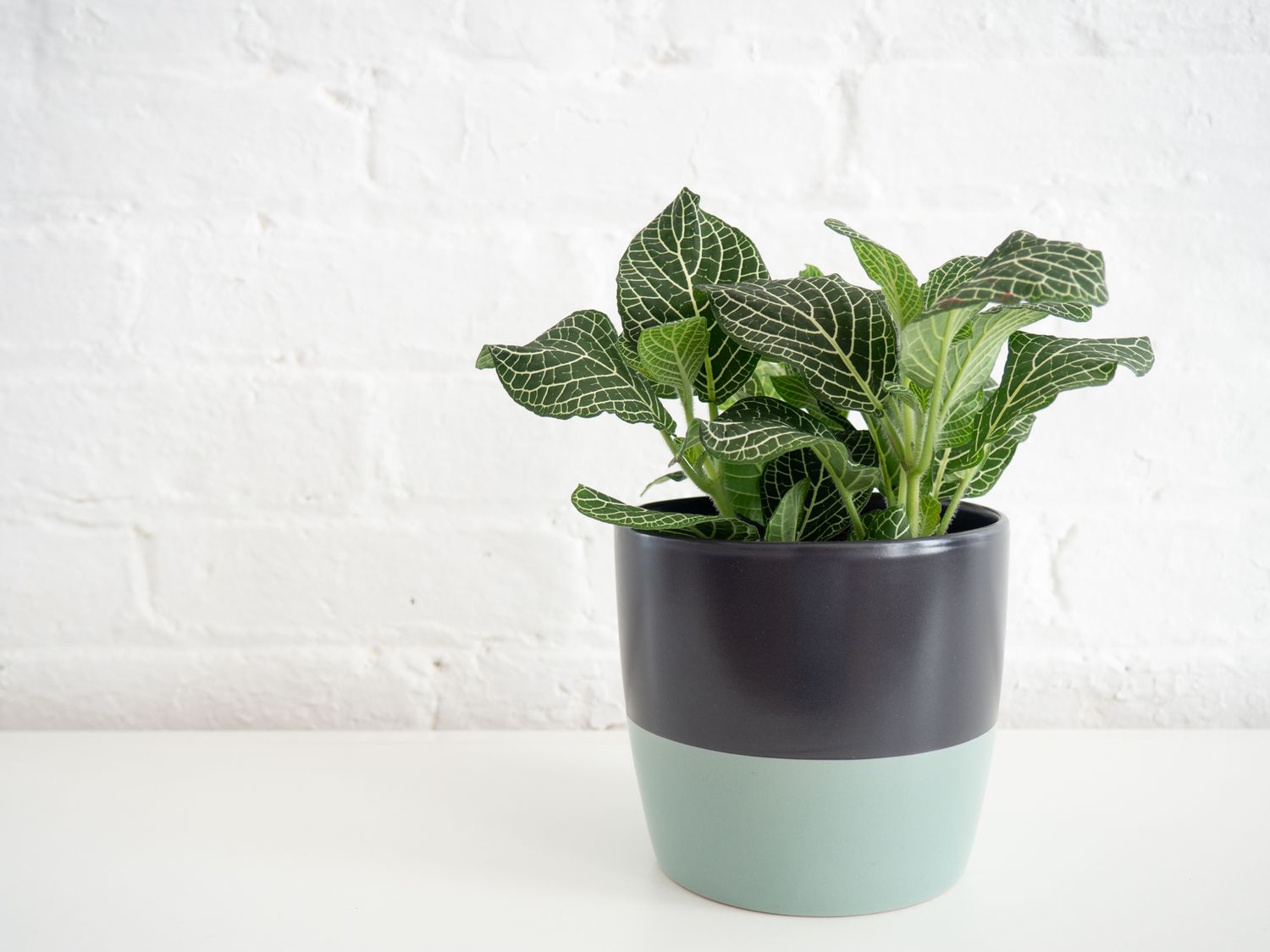
Fittonia, also known as Nerve Plant or Mosaic Plant, is a low-growing, creeping perennial known for its strikingly veined, colorful leaves.
The leaves are typically dark green with contrasting white, pink, or red veins, creating an intricate mosaic pattern. Fittonia produces small, inconspicuous white or pink flowers but is primarily grown for its ornamental foliage.
- Origin: Fittonia is native to the tropical rainforests of South America, particularly Peru, Bolivia, and northern Brazil.
- Blooming Month: Fittonia can produce small flowers year-round, but they are insignificant compared to the plant’s vibrant foliage.
- Height: Fittonia plants typically grow between 3 to 6 inches tall and can spread up to 12 inches wide.
- Care: Fittonia prefers bright, indirect light and consistently moist, well-drained soil. They thrive in high humidity environments and benefit from regular misting or being grown in a terrarium. Pinch back the stems to encourage fuller, bushier growth.
- Uses: Fittonia is primarily used as an ornamental houseplant or in terrariums. They make attractive ground covers in warm, humid environments and can be used in hanging baskets or as companion plants in dish gardens.
- Benefits: Fittonia helps to purify indoor air by removing trace amounts of pollutants, such as formaldehyde and benzene.
Fun Facts
- The genus name “Fittonia” honors Elizabeth and Sarah Mary Fitton, 19th-century Irish botanical writers and illustrators.
- Fittonia is sensitive to cold temperatures and will quickly wilt if exposed to drafts or cold air but can recover quickly when returned to ideal conditions.
- In the wild, Fittonia plants are often found growing on the forest floor, where they receive dappled sunlight and benefit from the high humidity of the rainforest environment.
26. Flaming Katy
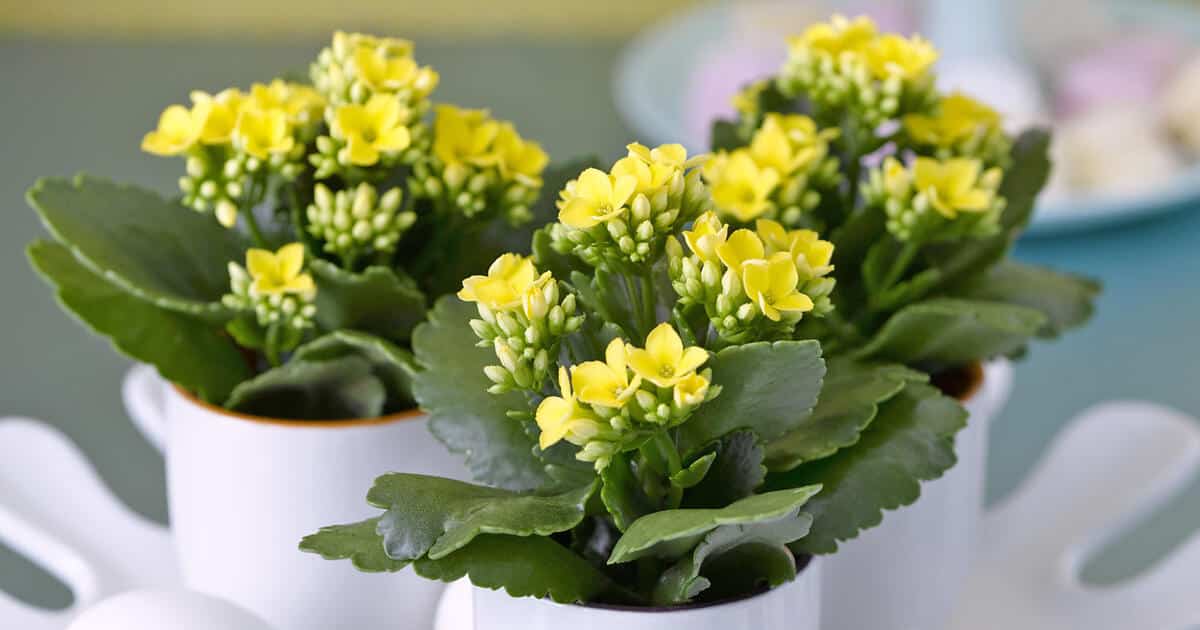
Flaming Katy (Kalanchoe blossfeldiana) is a succulent perennial plant known for its vibrant, long-lasting flower clusters in shades of red, orange, yellow, pink, or white.
The flowers are small, tubular, and held above the plant’s glossy, dark green, scalloped leaves. Flaming Katy has a compact, upright growth habit and is popular as a houseplant and for its ease of care.
- Origin: Flaming Katy is native to Madagascar.
- Blooming Month: Flaming Katy typically blooms in late winter to early spring, from January to March, with the potential for repeat blooming throughout the year with proper care.
- Height: Flaming Katy plants generally grow between 6 to 18 inches tall and 6 to 12 inches wide.
- Care: Flaming Katy prefers bright, indirect light and well-drained soil. Allow the soil to dry out between waterings, as the plant is susceptible to root rot if overwatered. Deadhead spent flowers to encourage reblooming and pinch back stems to maintain a compact shape.
- Uses: Flaming Katy is primarily used as a decorative houseplant or in container gardens. They make excellent gift plants and are popular during the winter months for their bright, colorful flowers.
- Benefits: Flaming Katy helps to purify indoor air by removing trace amounts of pollutants, such as formaldehyde and benzene.
Fun Facts
- The genus name “Kalanchoe” comes from the Chinese word “Kalan Chauhuy,” which means “that which falls and grows.”
- Flaming Katy is also known as “Widow’s Thrill,” “Christmas Kalanchoe,” or “Florist Kalanchoe,” due to its popularity as a gift plant during the winter holiday season.
- In its native habitat, Flaming Katy is pollinated by sunbirds, which are attracted to the plant’s brightly colored, nectar-rich flowers.
27. French Lavender
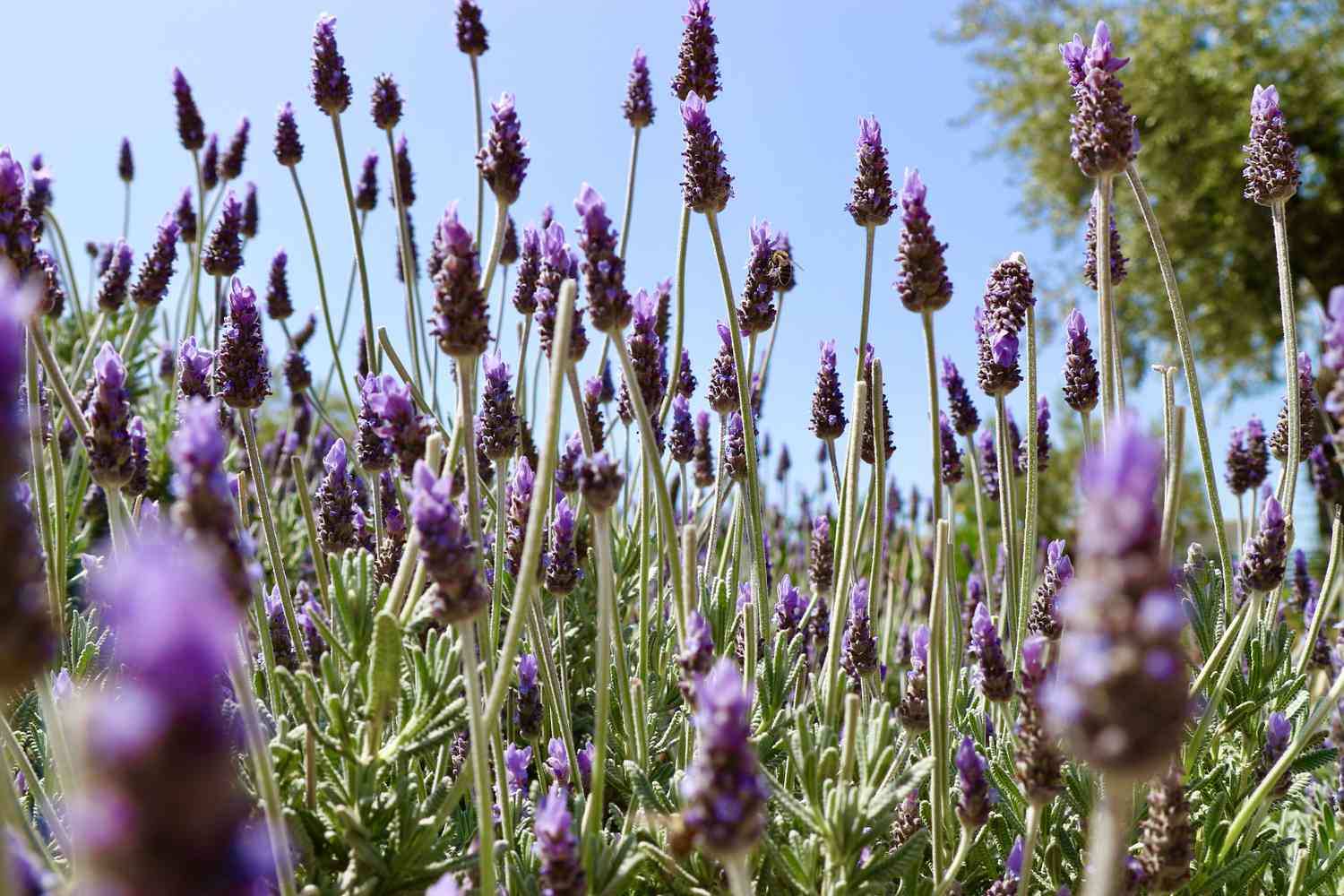
French Lavender (Lavandula dentata) is an aromatic evergreen shrub known for its fragrant, pale purple flowers and toothed, silvery-green leaves.
The flowers are arranged in spikes at the tips of long, slender stems and have a distinct, lavender aroma. French Lavender has a compact, mounding growth habit and is prized for its ornamental and culinary uses.
- Origin: French Lavender is native to the Mediterranean region, including Spain, France, and Italy.
- Blooming Month: French Lavender typically blooms from mid-summer to early fall, from July to September.
- Height: French Lavender plants can grow between 1 to 3 feet tall and 1 to 2 feet wide, depending on the cultivar and growing conditions.
- Care: French Lavender prefers full sun and well-drained, sandy soil. They are drought-tolerant once established and require minimal watering. Prune the plant after flowering to maintain its shape and encourage bushier growth.
- Uses: French Lavender is used as an ornamental plant in gardens, borders, and rock gardens. The flowers and leaves are used in culinary applications, such as in herbal teas, baked goods, and as a flavoring for meats and vegetables.
- Benefits: French Lavender has been used in traditional medicine for its calming and relaxing properties. The essential oil derived from the plant is used in aromatherapy and personal care products.
Fun Facts
- The name “Lavender” comes from the Latin word “lavare,” meaning “to wash,” as the plant was often used to scent baths and laundry in ancient times.
- French Lavender is not typically used for commercial lavender oil production, as its oil has a slightly different scent profile compared to other lavender species.
- In the language of flowers, lavender symbolizes purity, devotion, and serenity.
28. Fleabane
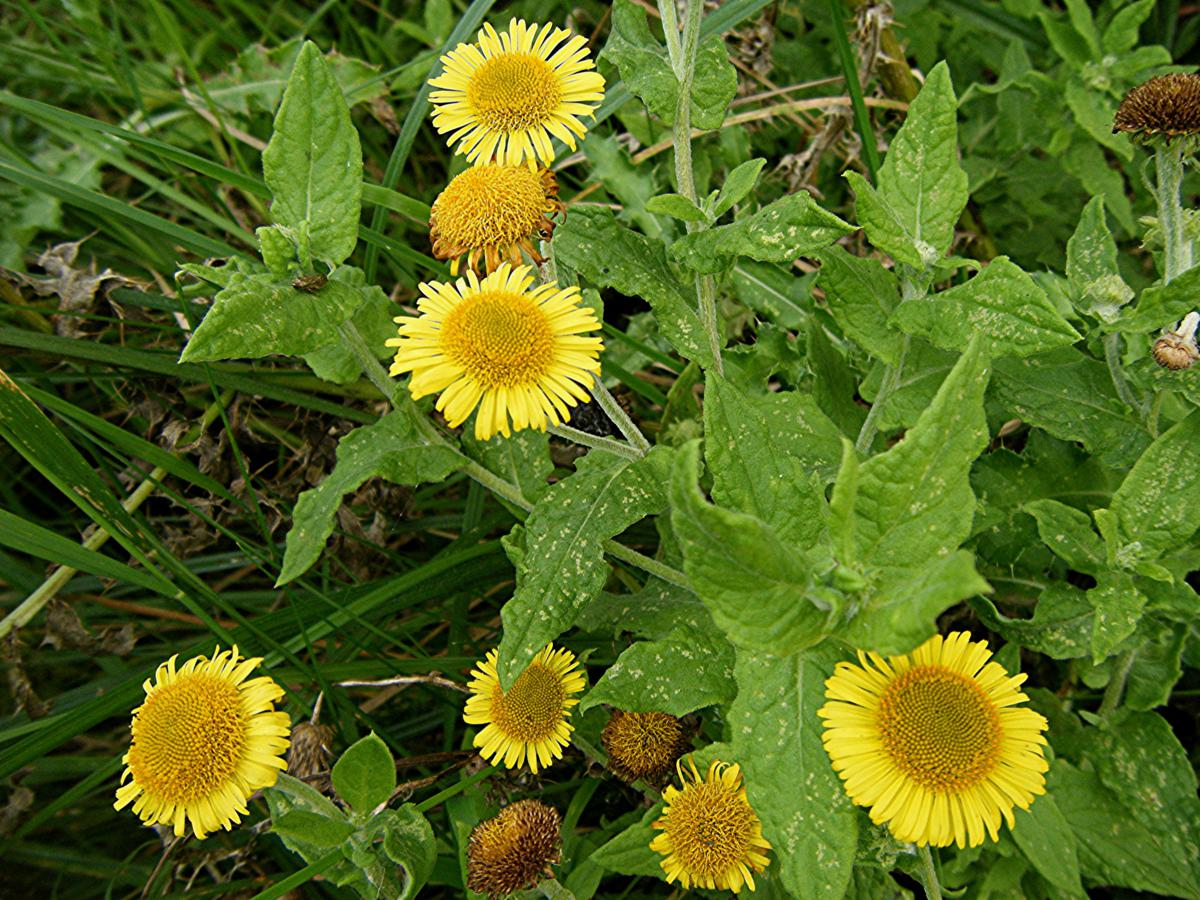
Fleabane (Erigeron) is a genus of annual, biennial, and perennial plants known for their small, daisy-like flowers with yellow centers surrounded by numerous thin, often pink, purple, or white ray florets.
The leaves are typically narrow, lance-shaped, and arranged alternately along the stems. Fleabane plants have a clumping or spreading growth habit and are found in various habitats, from gardens to wild areas.
- Origin: Fleabane species are native to various regions worldwide, including North America, Europe, Asia, and Africa.
- Blooming Month: Fleabane blooming time varies by species, with most blooming from spring to summer, and some extending into early fall.
- Height: Fleabane plants can range in height from a few inches to over 3 feet tall, depending on the species and growing conditions.
- Care: Most Fleabane species prefer full sun to partial shade and well-drained soil. They are generally low-maintenance and can tolerate a range of soil types. Deadheading spent flowers can prolong the blooming period.
- Uses: Fleabane is used as an ornamental plant in gardens, wildflower meadows, and naturalized areas. Some species are also used in traditional medicine for various purposes.
- Benefits: Fleabane flowers attract pollinators, such as bees and butterflies, supporting local ecosystems. Some species have been used in herbal remedies for their alleged anti-inflammatory and astringent properties.
Fun Facts
- The common name “Fleabane” comes from the belief that the dried flowers and leaves of the plant could repel fleas when stuffed into mattresses or pet bedding.
- The genus name “Erigeron” is derived from the Greek words “eri,” meaning early, and “geron,” meaning old man, referring to the plant’s early flowering and the grayish-white appearance of the seed heads.
- Some Fleabane species, such as the seaside daisy (Erigeron glaucus), are popular choices for coastal gardens due to their tolerance of salt spray and sandy soils.
29. Fireweed
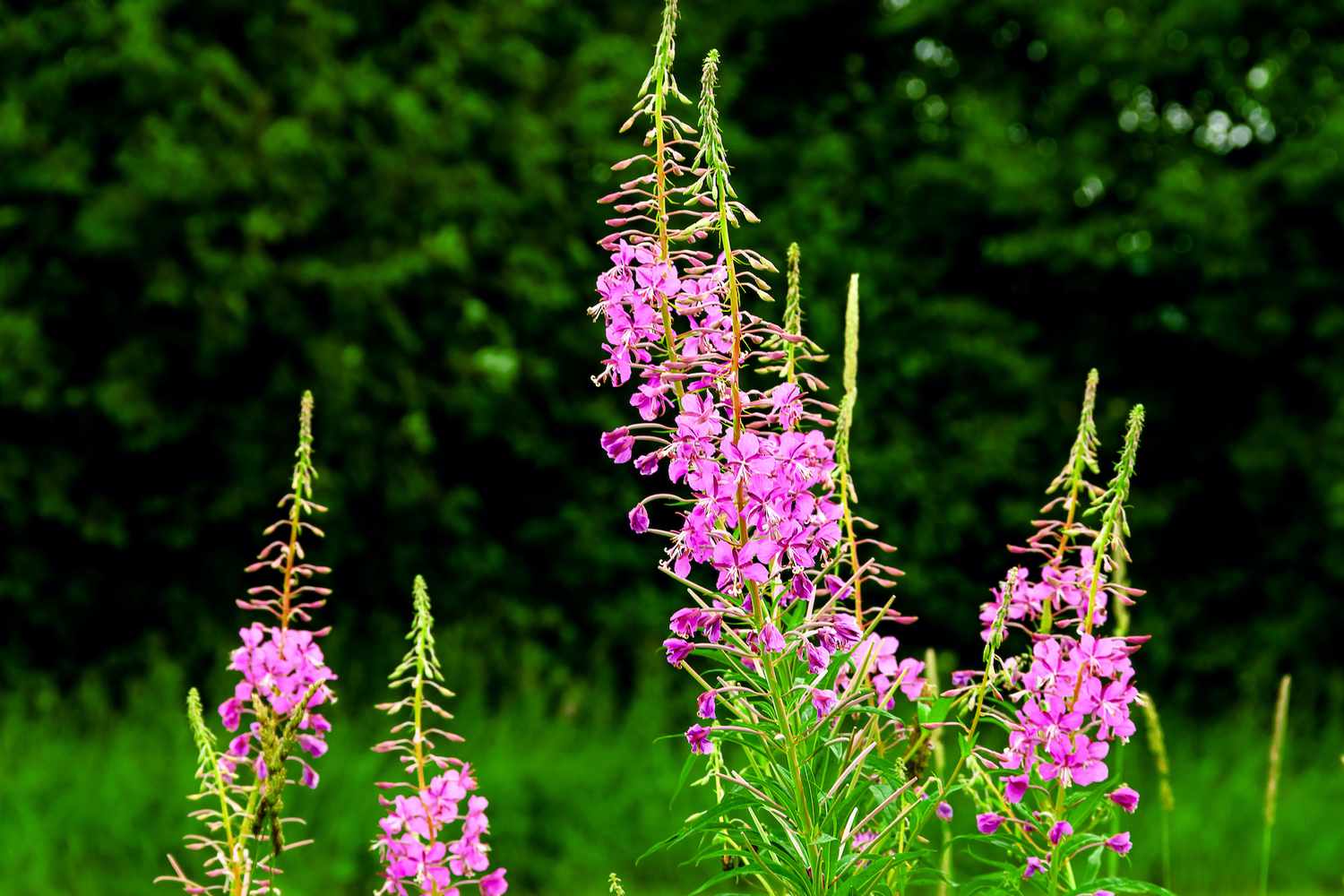
Fireweed (Chamaenerion angustifolium) is a tall, herbaceous perennial plant known for its showy spikes of pink to purple flowers and long, narrow leaves.
The flowers have four petals and are arranged in a terminal raceme, blooming from the bottom of the spike upwards. Fireweed has reddish stems and can form extensive colonies through its vigorous rhizomes.
- Origin: Fireweed is native to temperate regions of the Northern Hemisphere, including North America, Europe, and Asia.
- Blooming Month: Fireweed typically blooms from mid-summer to early fall, from July to September.
- Height: Fireweed plants can grow between 3 to 8 feet tall, depending on the growing conditions.
- Care: Fireweed prefers full sun to partial shade and moist, well-drained soil. They can tolerate a wide range of soil types and are often found in disturbed areas, such as burned or cleared sites. Cut back the stems after flowering to prevent self-seeding.
- Uses: Fireweed is used as an ornamental plant in wildflower gardens, naturalized areas, and for erosion control. The young shoots and leaves are edible and can be used in salads or cooked as a vegetable.
- Benefits: Fireweed is an important nectar source for bees, butterflies, and other pollinators. The plant has been used in traditional medicine for its astringent and anti-inflammatory properties.
Fun Facts
- The name “Fireweed” comes from the plant’s ability to quickly colonize areas that have been burned by wildfire, often being one of the first plants to appear after a fire.
- Fireweed is the floral emblem of Yukon, Canada, and is also known as “Rosebay Willowherb” in some regions.
- In World War II, fireweed fibers were used as a substitute for cotton in the production of fabric and rope due to shortages caused by the war.
30. Field Poppy
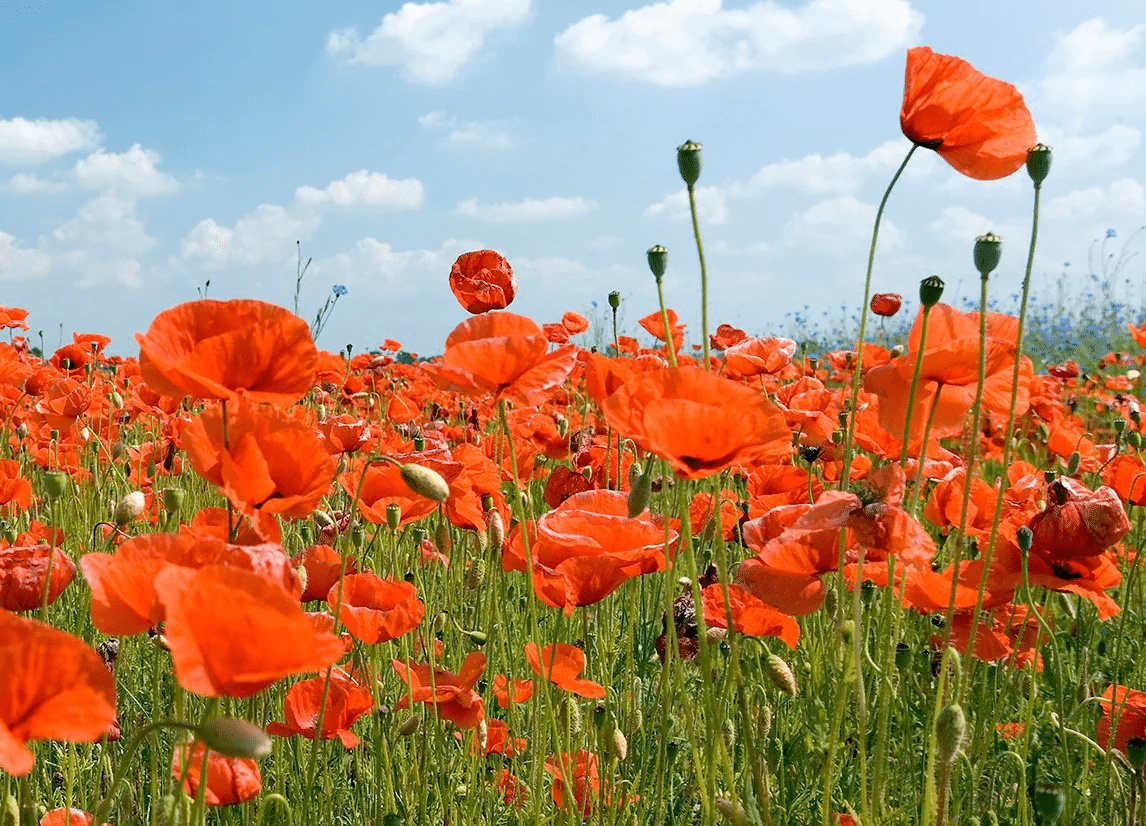
Field Poppy (Papaver rhoeas) is an annual herbaceous plant known for its vibrant, red flowers with a black center and delicate, papery petals.
The flowers are solitary and held above the plant’s hairy, deeply lobed leaves. Field Poppy has a slender, erect stem and a tap root system.
- Origin: Field Poppy is native to Europe, North Africa, and temperate regions of Asia.
- Blooming Month: Field Poppy typically blooms from late spring to mid-summer, from May to July.
- Height: Field Poppy plants generally grow between 1 to 2 feet tall.
- Care: Field Poppy prefers full sun and well-drained soil. They are often grown as annual wildflowers and self-seed readily. Deadhead spent flowers to prolong the blooming period and control self-seeding.
- Uses: Field Poppy is widely used as an ornamental plant in wildflower gardens, meadows, and naturalized areas. The flowers are also used in floral arrangements and for their symbolic significance.
- Benefits: Field Poppy flowers provide nectar and pollen for bees and other pollinators. The plant has been used in traditional medicine for its sedative and pain-relieving properties, although its use should be under the guidance of a healthcare professional.
Fun Facts
- Field Poppy is a symbol of remembrance for fallen soldiers, particularly associated with World War I and Remembrance Day (November 11th) in many countries.
- In ancient Greek mythology, the poppy was associated with Demeter, the goddess of agriculture, and Hypnos, the god of sleep, due to its sedative properties.
- The vibrant red color of Field Poppy flowers is due to the presence of pigments called anthocyanins, which are also found in many fruits and vegetables.
31. Fenestraria
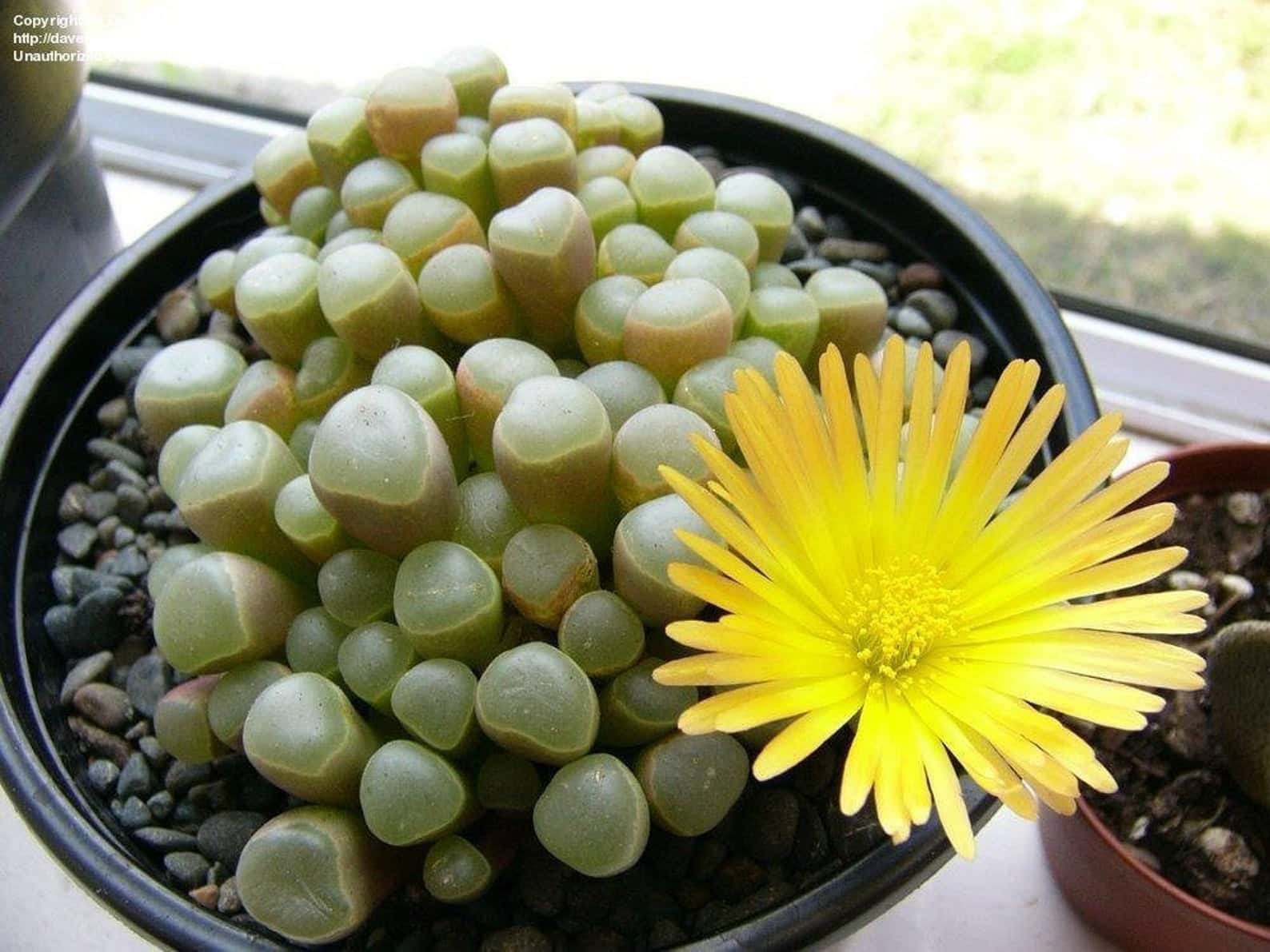
Fenestraria, also known as Baby Toes or Window Plant, is a small, succulent plant native to the deserts of southern Africa.
It is known for its unique, cylindrical leaves that have translucent “windows” at the tips, allowing light to penetrate and reach the photosynthetic tissues within the leaves.
The leaves are arranged in small clusters and are usually grayish-green in color. Fenestraria produces small, daisy-like white or yellow flowers that emerge from the center of the leaf clusters.
- Origin: Fenestraria is native to the desert regions of Namibia and South Africa.
- Blooming Month: Fenestraria typically blooms in late summer to early fall, although flowering is not common in cultivation.
- Height: Fenestraria plants are small, usually growing only 1 to 2 inches tall and forming small clumps.
- Care: Fenestraria requires well-draining soil and minimal watering, as they are adapted to arid environments. They prefer bright, indirect light and can tolerate some direct sun. Allow the soil to dry out completely between waterings, and avoid getting water on the leaves to prevent rot.
- Uses: Fenestraria is primarily grown as an ornamental plant, prized for its unique leaf structure and as a collectible succulent. They are well-suited for small pots, terrariums, and rock gardens.
- Benefits: As a succulent, Fenestraria is efficient at conserving water and can help to purify indoor air by removing trace amounts of pollutants.
Fun Facts
- The genus name “Fenestraria” comes from the Latin word “fenestra,” meaning window, referring to the translucent windows on the tips of the leaves.
- The window-like leaf tips of Fenestraria allow light to penetrate the leaves while protecting the plant from the intense sun and heat of its native desert habitat.
- Fenestraria is a member of the Aizoaceae family, which includes many other succulent plants known for their unique leaf structures and adaptations to arid environments.
Conclusion
From the delicate, fringe-like petals of the Fringe Flower to the striking, flame-like blooms of the Flame Lily, this journey through 30 beautiful flowers beginning with the letter “F” has showcased an incredible array of colors, shapes, and sizes.
As we’ve discovered, these plants not only add visual appeal to gardens and homes but also offer various benefits, such as attracting pollinators, purifying the air, and providing food and medicine.
Whether an experienced gardener or a plant enthusiast, consider incorporating some of these fascinating “F” flowers into your collection.
By doing so, you’ll enhance the beauty and diversity of your surroundings while also supporting the ecosystems that depend on them.
With so many wonderful options, the possibilities for creating a captivating and thriving garden are truly endless.


